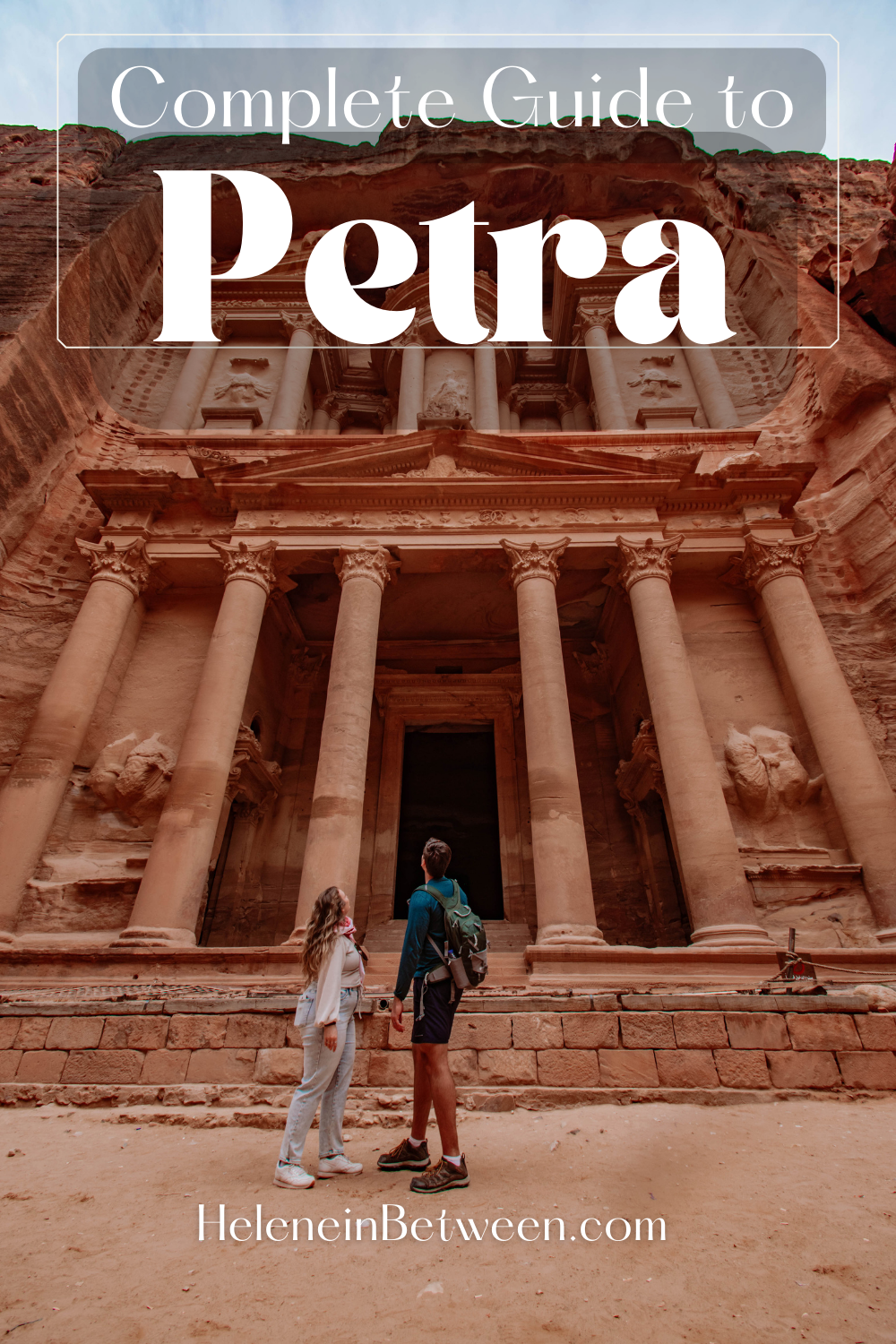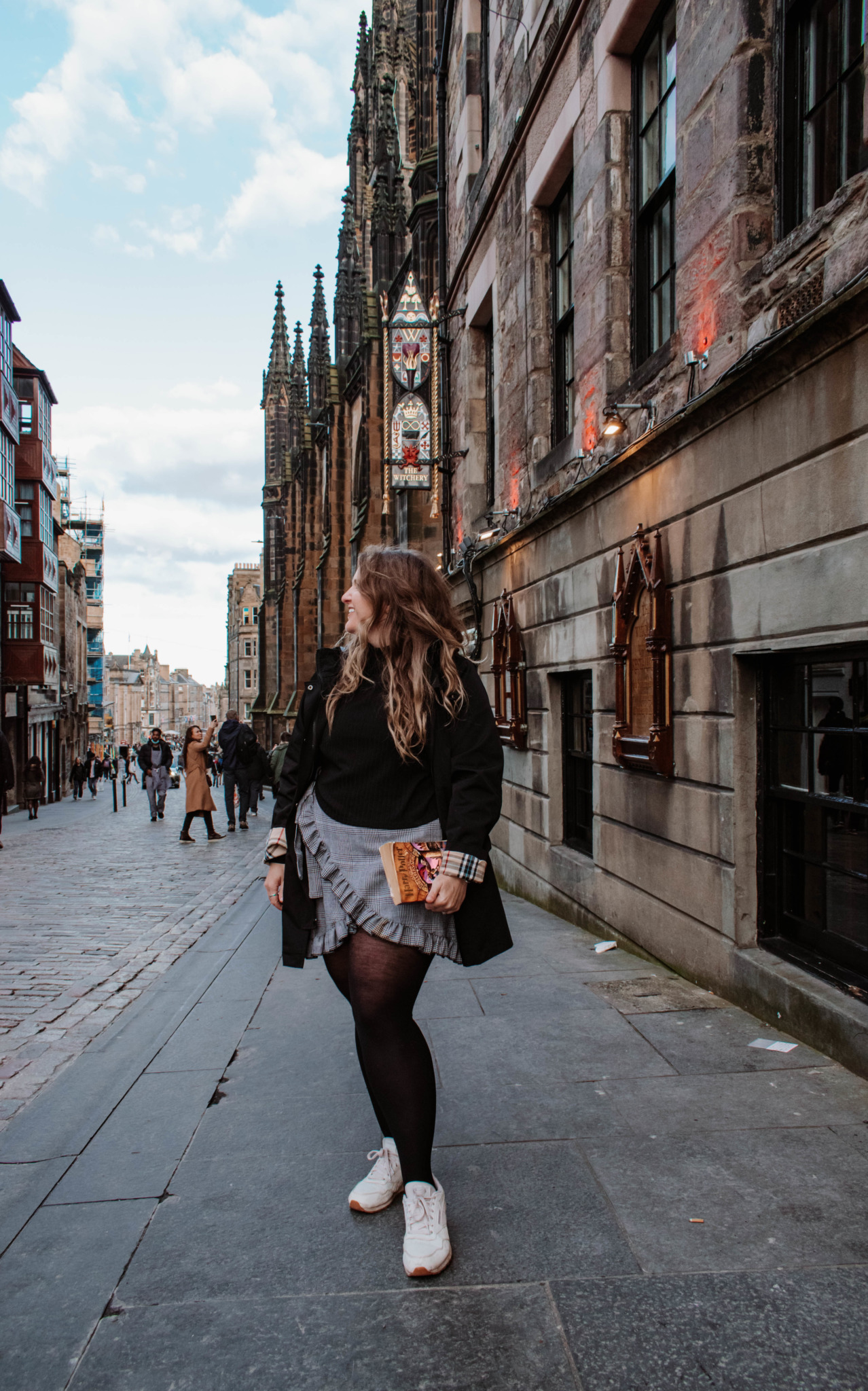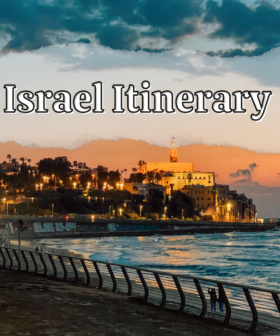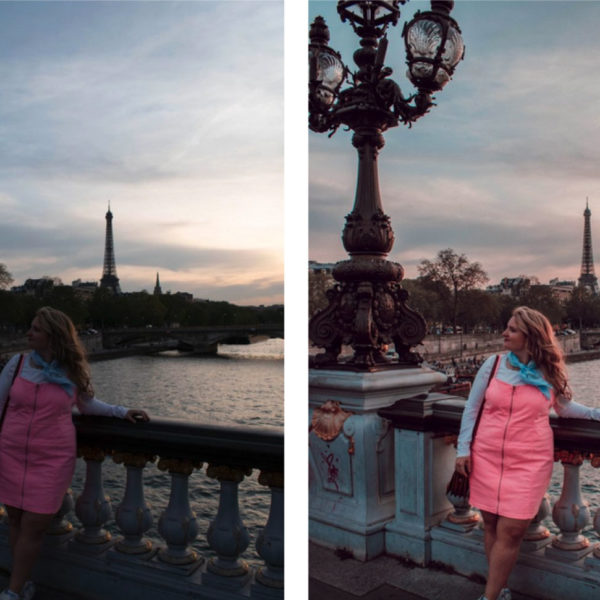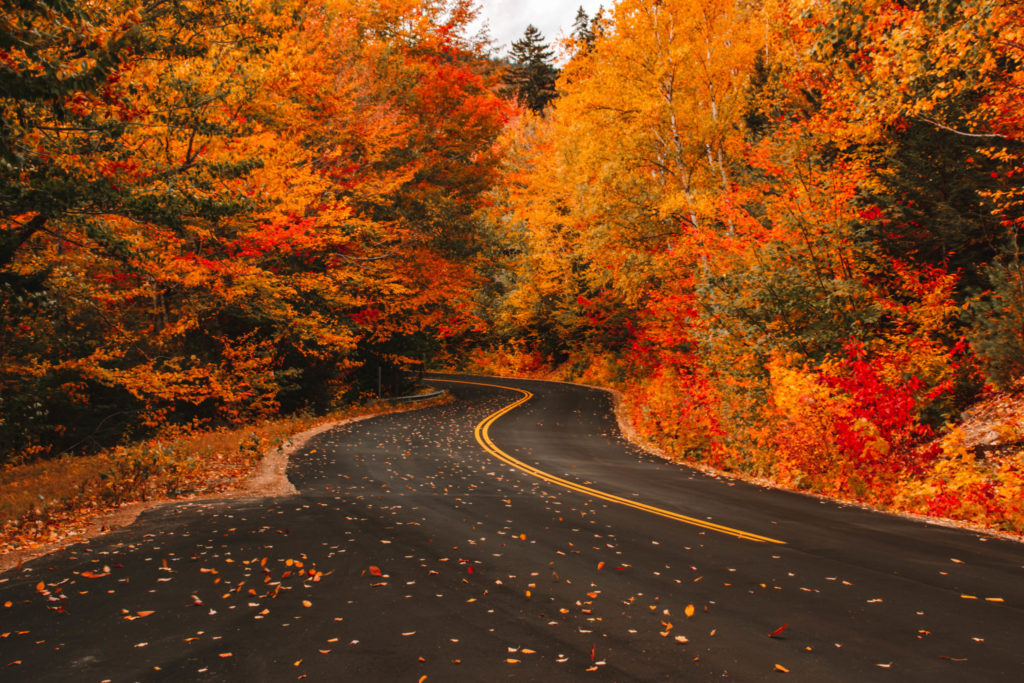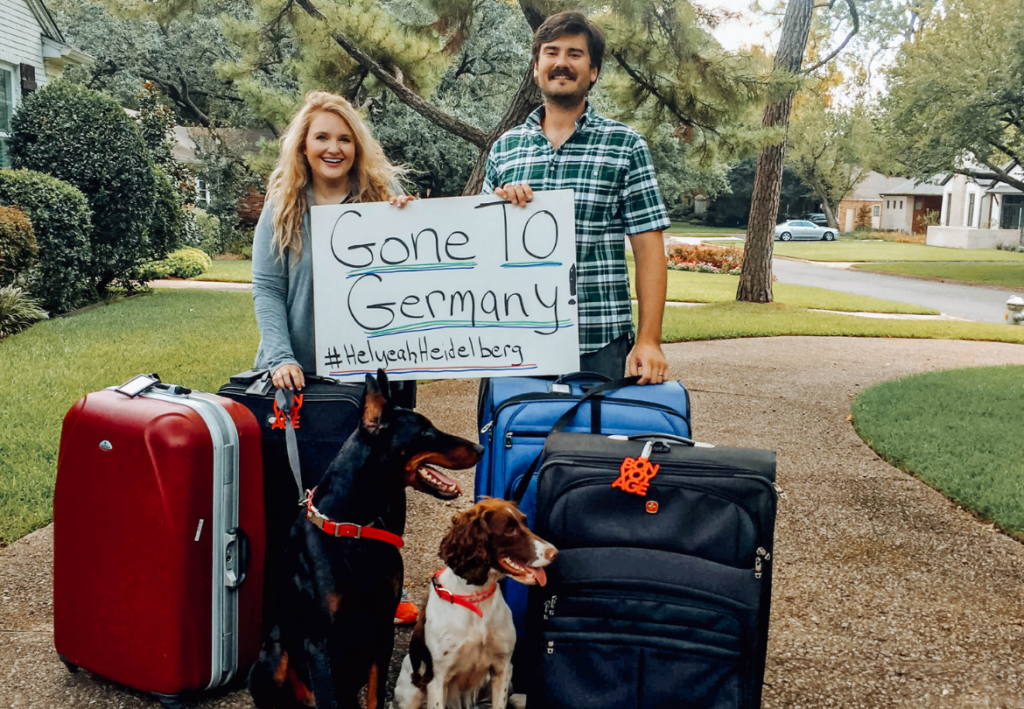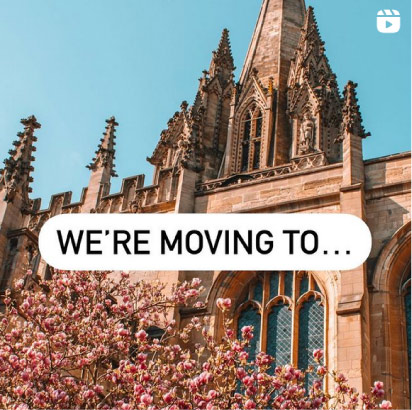Jordan, with its spectacular desert scenery, fascinating archeological sites, delectable cuisine, and fair weather, is one of the best places to explore in the Middle East.
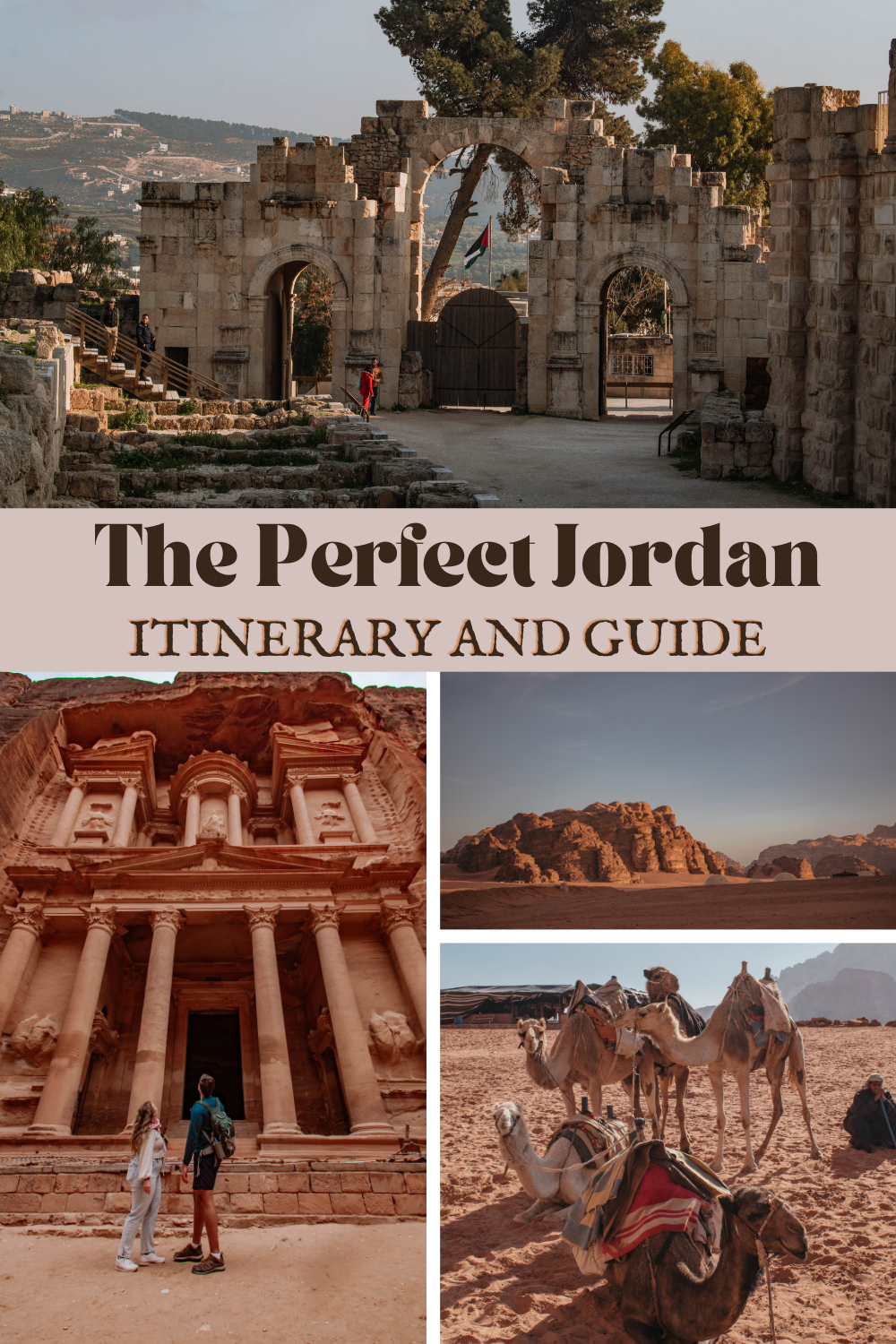
Whether you have a week or 10 days, I've got a full itinerary and travel guide for your time in Jordan. It's one of those places you definitely need more than 3 days to explore.
I went to Jordan without expectations. I left feeling like I absolutely must come back. Incredibly generous, kind people, delicious food, and overwhelming beauty and history. Jordan is a country that will surprise and delight you. This guide will help you make the most of your visit.
[toc]
Jordan Itinerary at A Glance
Day 1- Amman
Day 2 – Amman and Jerash
Day 3 – Wadi Rum
Day 4 – Petra
Day 5 – Petra – Kerak Castle – Wadi Mujib – Dead Sea
Day 6 – Dead Sea & Baptism Sites
Day 7 – Dead Sea & Amman
What to Expect
Jordan is one of the most welcoming and hospitable countries in the world. People are incredibly open and kind, always willing to talk or help you with directions or advice. The food with a variety of dishes is delicious, there are epic places to discover and the religious and historical sites are mesmerizing.
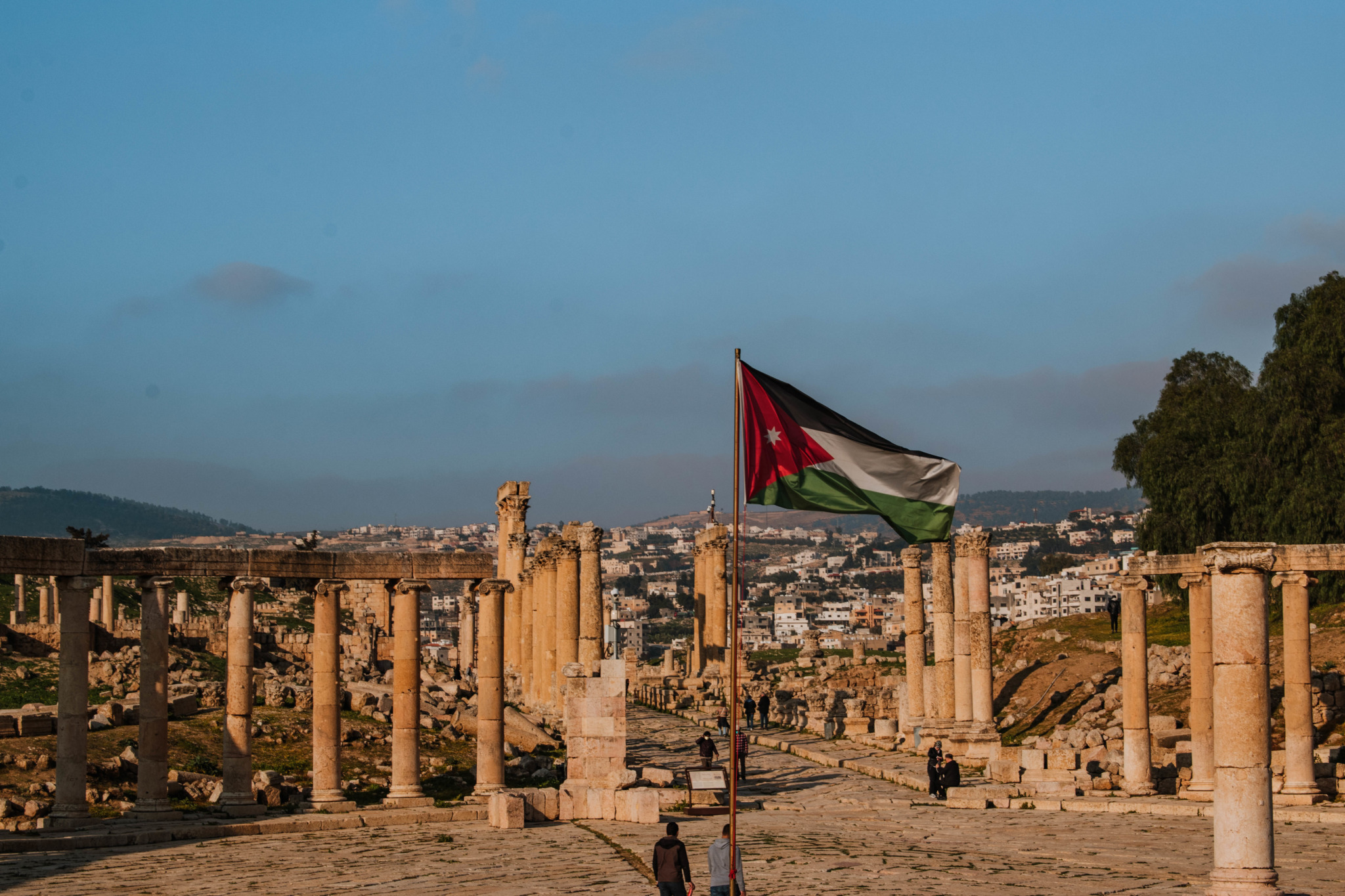
Jordan is a Muslim country but you are perfectly fine to not cover your hair as a woman. Some women do, but many don't and you'll find a variety of clothing and styles. You don't need to cover up, but it is important to dress modestly. Avoid short dresses or skirts. Dress for the weather. It can get hot during the day and cool at night especially in the desert.
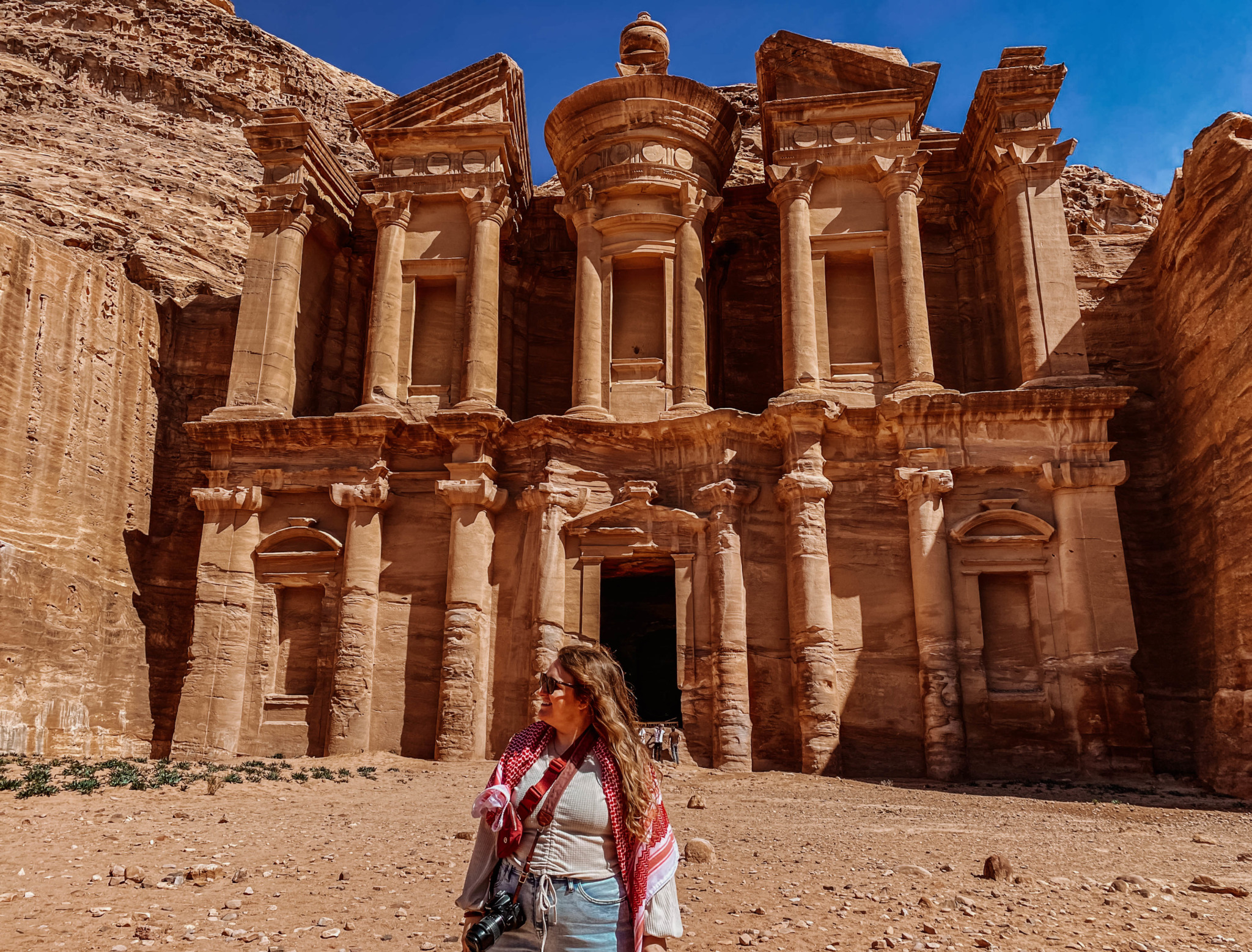
You will hear a call to prayer in most major cities. If you are visiting on a Friday, some traditional markets and shops might be closed during prayer time, as Friday is a holy day in the Muslim religion. Sunday is the start of the work week, having Friday and Saturdays off, as opposed to Saturday and Sunday off in the USA and Europe.
I found Jordan to be be very safe, and as a woman a wonderful place to travel.
Taking a Tour
I think the absolute best way to see Jordan is with a tour. I recommend Globus which organizes your trip from start to finish. I've been lucky enough to travel many times with Globus but this trip to Jordan was my absolute favorite.
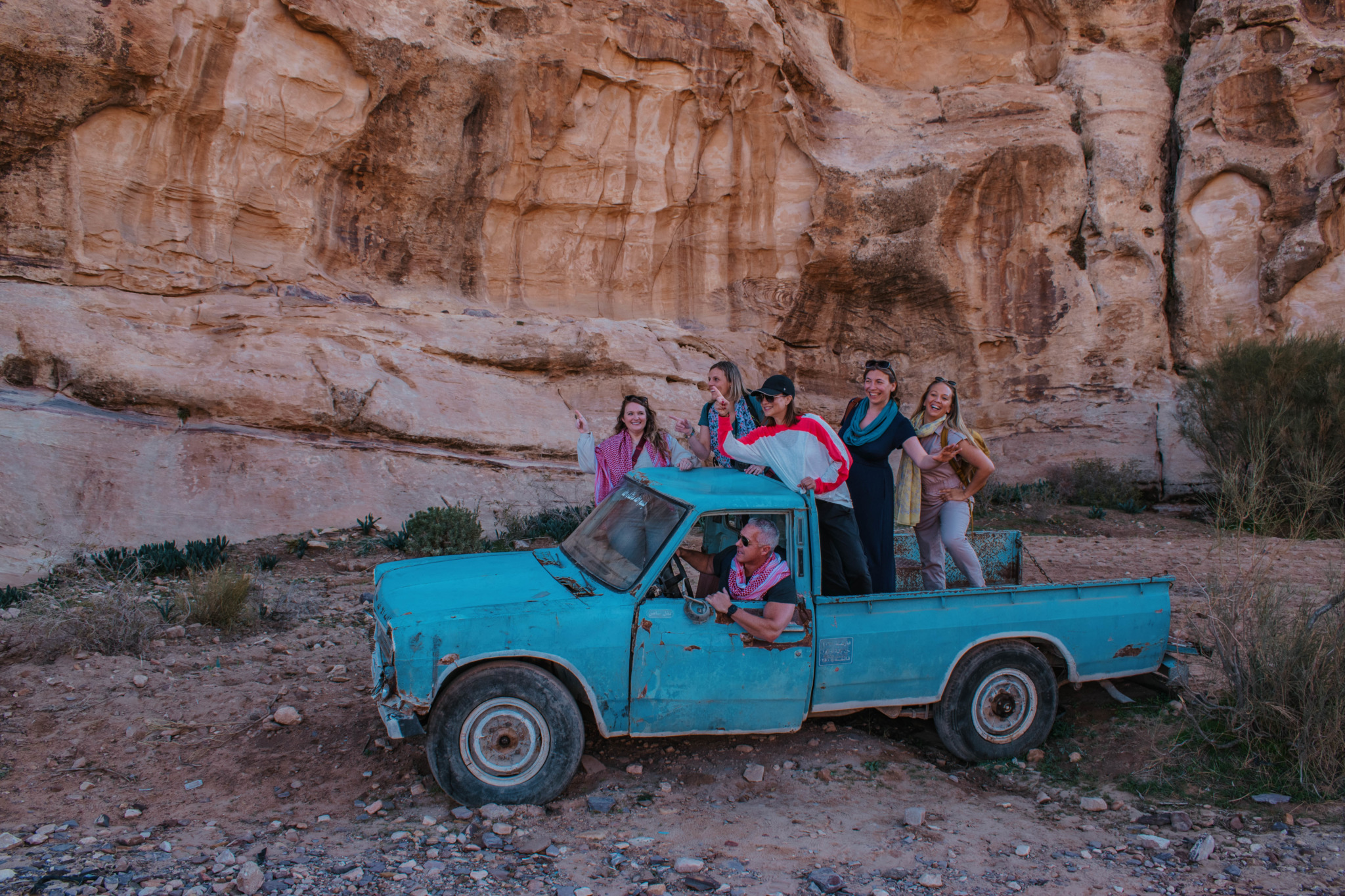
Everything is organized for you from the seamless airport pickup, beautiful hotels, and unique experiences while still remaining affordable travel. The hotels were all absolutely stunning, some even 5 star! The VIP sightseeing was well planned and there was free time to explore on your own.
Globus takes care of all your travel needs. From taking your luggage off the bus and putting it in your room to organizing your required COVID exam the day before you return to the United States.
But the best part of touring with Globus is the incredible guide. Our tour guide, Osama, was with us every step of the way. Not only did he tell us the history of what we saw, he told us fun facts, and we were free to ask questions about the traditions and customs of Jordanians.
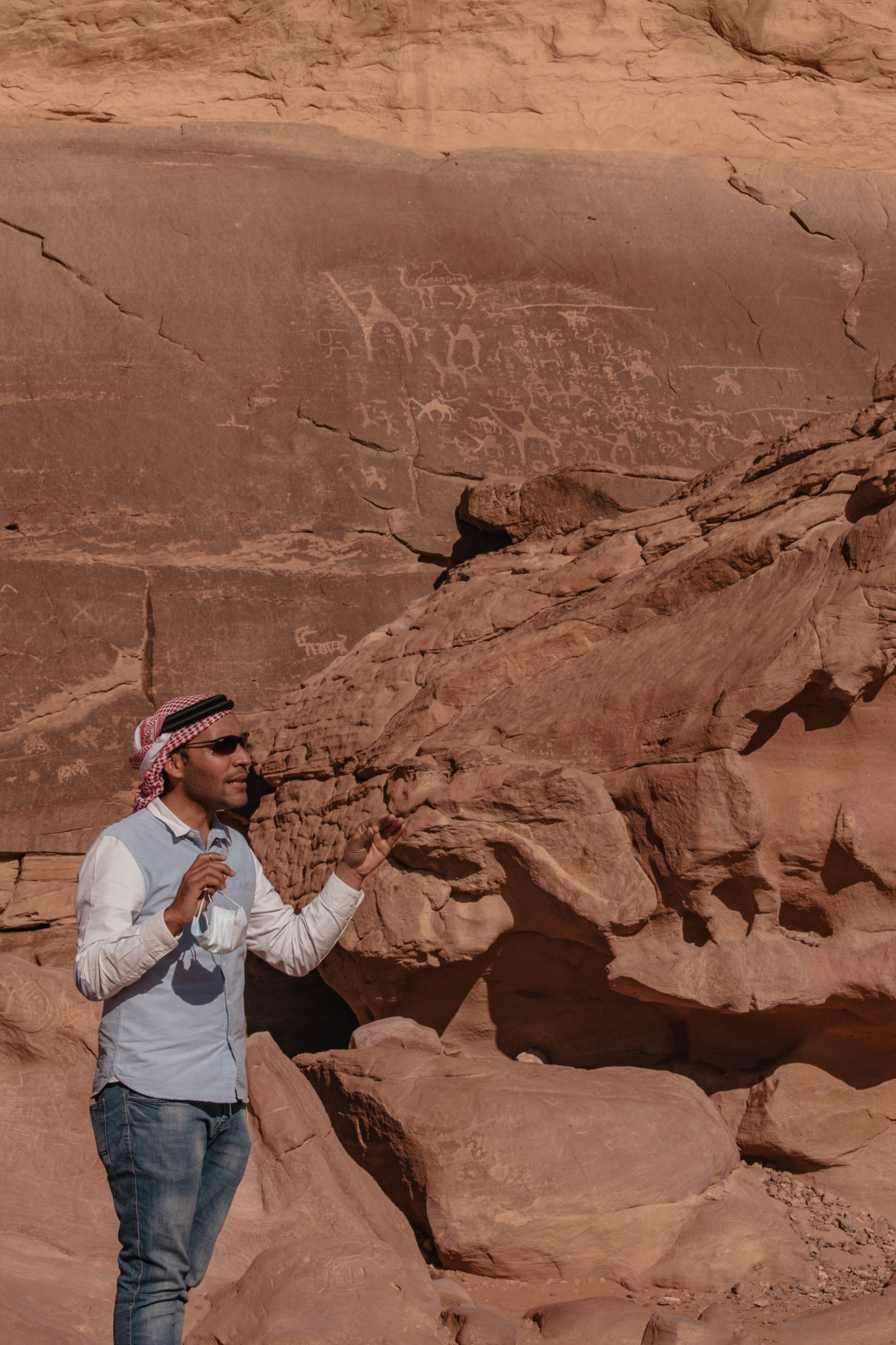
Globus Escapes is such a unique and wonderful concept. Tours are competitively priced and during off season. You save money and miss the crowds. This is truly the best way to experience Jordan.
When to Visit Jordan
February through May, early to mid spring, is typically best for visiting Jordan. You'll have nice temperatures. It's not too hot but can get chilly at night and windy near the Dead Sea. This is also great for hiking Petra or the Wadi Rum desert.

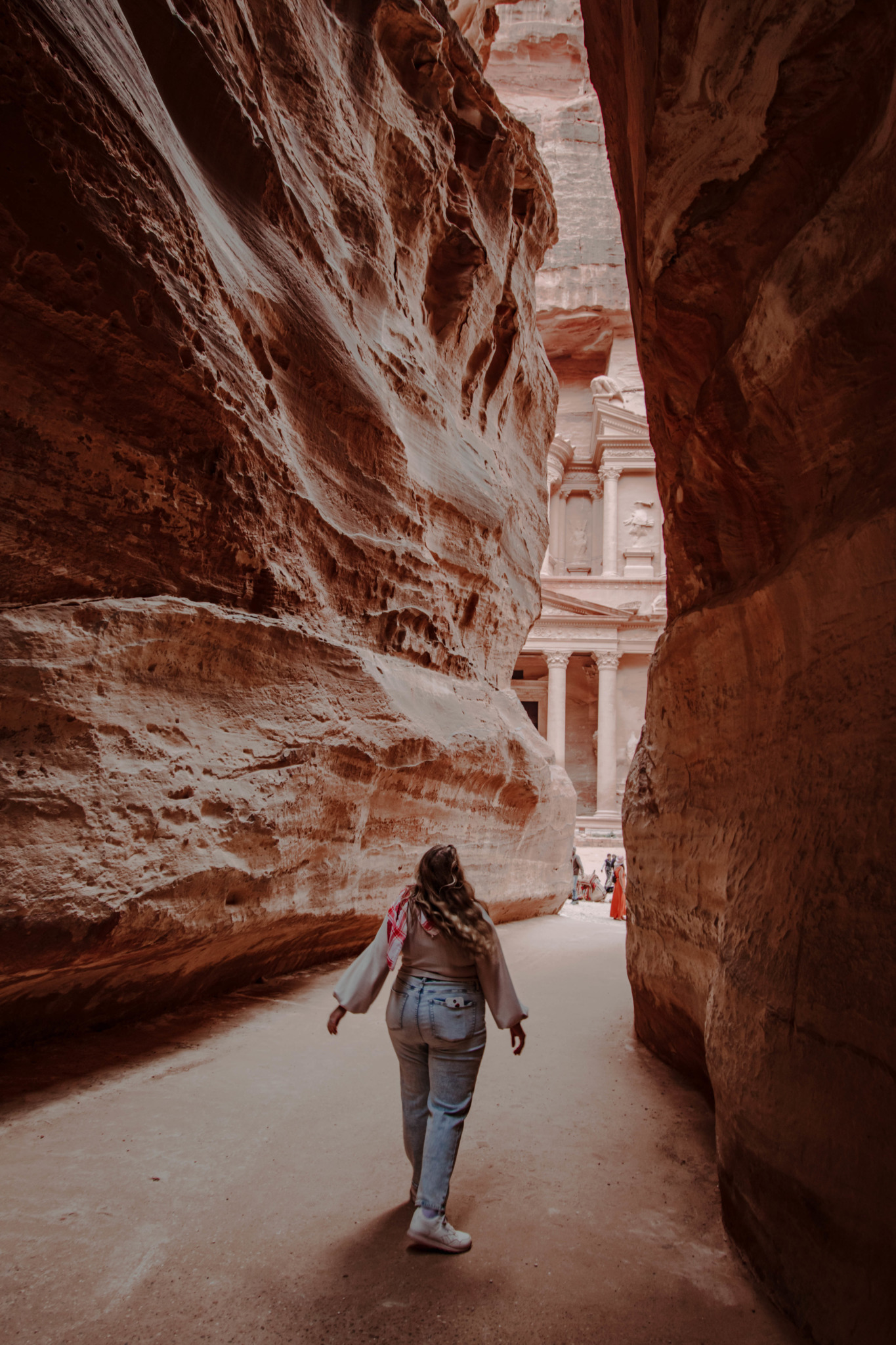
I suggest avoiding summer as it can get quite hot. September through early November is also good as well since it's not quite as hot.
How Long to Stay in Jordan
I think seven days is the perfect amount to get a good feel for Jordan. You'll get to experience the major attractions including Petra, Wadi Rum and Amman. Plus you'll have time to relax, shop and take tours too.
Jordan Itinerary
Day 1 – Amman
We flew into the Queen Alia International Airport and Globus arranged a pick up. But this was not your average pickup! You'll be taken directly from your gate and through customs in a seamless and easy way. This service makes your travel stress-free and easy. We then took the car service directly to the hotel.
Amman, Jordan's capital, is a great place to start your trip. The city is spread out and has a lot to offer, from Roman ruins to great restaurants. The city is very walkable so I recommend for your first day to walk around town and have a bite to eat.

This is the largest city in Jordan with 4.5 million people and over half a million that drive in to work every day. It's known as the City of Seven Hills because of its history of Roman rule.
I was surprised to find a great mix of modern architecture mixed in with antiquity. You'll see street art, hip cafes, book shops, and local restaurants perfuming the air with delicious treats.

Rainbow Street is a great place to walk around, stop in a restaurant and get your bearings. Check out the Royal Automobile Museum to see one of the best collections of beautiful antique cars from King Hussein. Or, check out King Abdullah's Mosque.
Where to stay in Amman: Globus arranged for us to stay at Kempinski Hotel – a perfect spot to explore the city! This was a modern, lovely hotel with an included buffet breakfast and dinner with your Globus tour.
Day 2 – Amman and Jerash
Make your way to the historic site of the Amman Citadel, which is in the heart of town. The city's original name, Rabbath-Ammon, means “capital of Ammon” and was coined by the Romans after they built the citadel, which is one of the world's oldest inhabited settlements.

The city's name was then changed by the Greeks to “Philadelphia” which means city of brotherly love and then, finally Amman.
You'll walk through the ancient gate that once led to the city and find the Temple Of Hercules. Built during Marcus Aurelius' seat as emperor, this temple has stood the test of time, despite earthquakes.
Leave some time to take in the museum inside the citadel, Jordan Archaeological Museum, filled with artifacts and information about the city, the ruins, and its people. Walk around the ruins and look down below at the sprawling city of Amman. You can see the Roman Forum below. You'll also find a huge, marble remnant of a hand of Hercules and it's speculated this was one of the largest marble statues known to man.

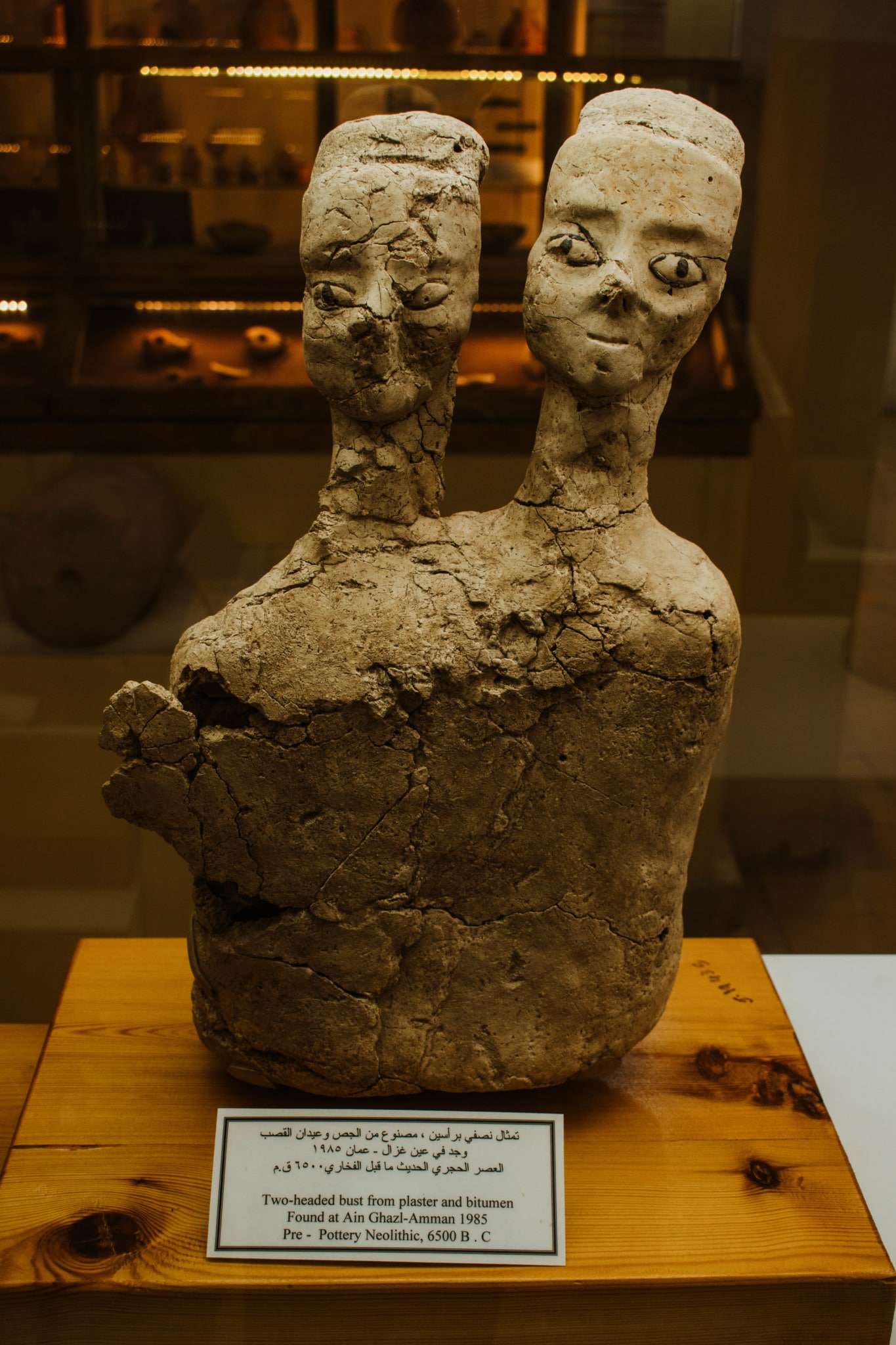
Next, our guide took use to Wasat Al-Balad in Downtown Amman. You'll find lots of shops selling fresh fruits and vegetables, clothing, and cafes. Make a stop at Habibah Sweets for traditional “Kunafeh” a dessert of fried goat cheese topped with dough and honey.

Then, it was time to head to Jerash, one of the best preserved Roman ruins outside of Rome!
Jerash is about an hour north of Amman and on our way we stopped off in the small village of Souf for a homemade traditional lunch at Beit Khairat Souf. There were piles of lamb kebab, steaming pots of tea, plates of hummus, and salads of every kind.
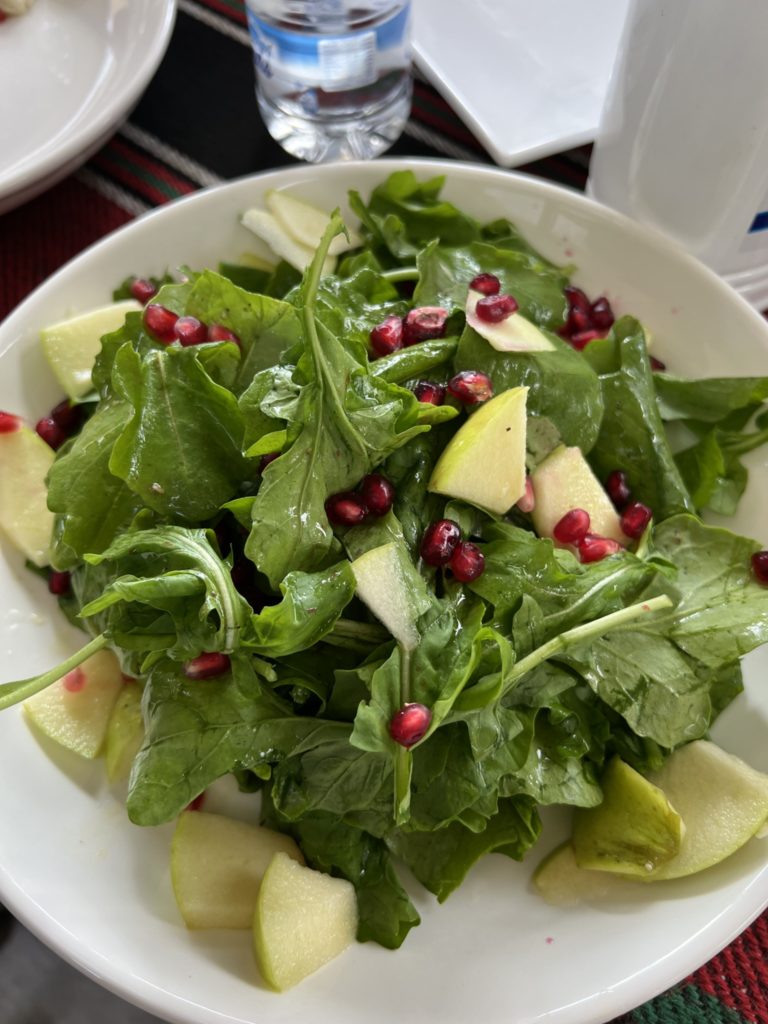

The food was absolutely divine and such a wonderful, unique experience organized by Globus. The restaurant is part of Beit Khairat Souf’s Women’s Community Project created to help women financially support themselves.
Jerash
Just an hour north of Amman is the ancient city of Jerash. This well-preserved Roman ruin is one of the most impressive I've ever seen! I really enjoyed my time here. With sweeping views and incredible history, this site in Jordan cannot be missed.
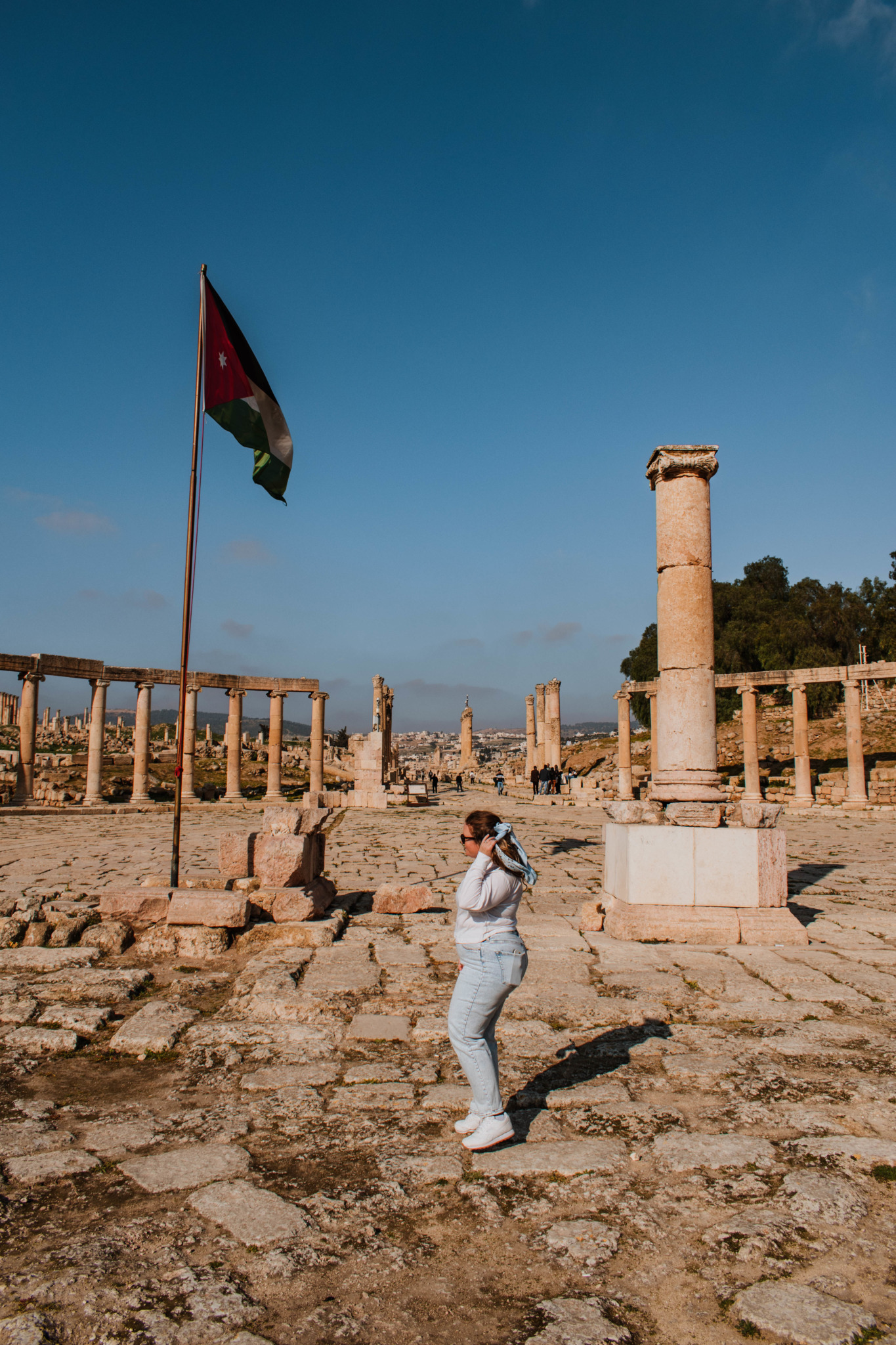

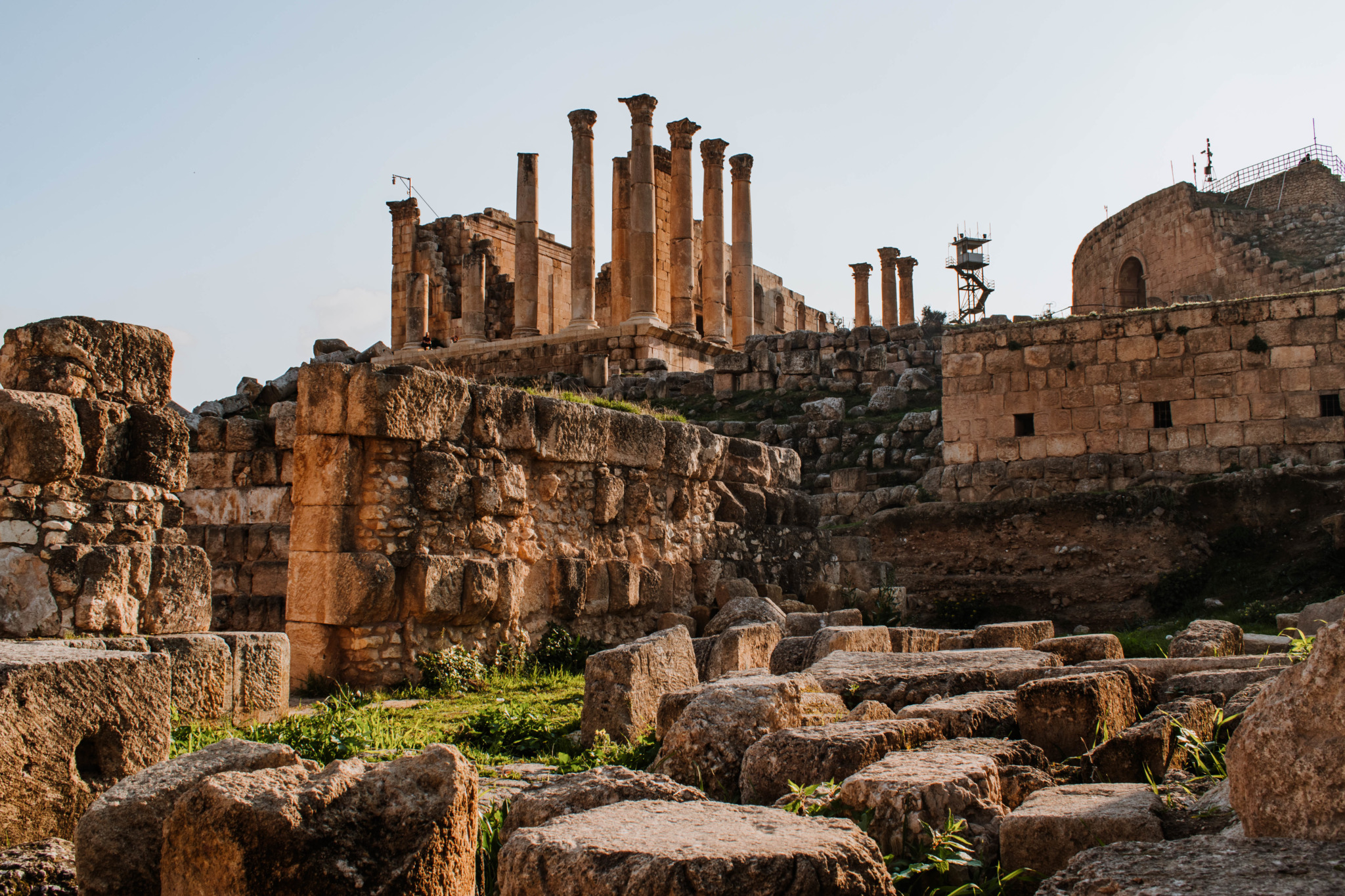
What I found most fascinating, besides the nearly intact Jerash theater, hippodrome, temple of Zeus and Artemis, Forum, and Hadrian's Arch, was that much of it is still standing!
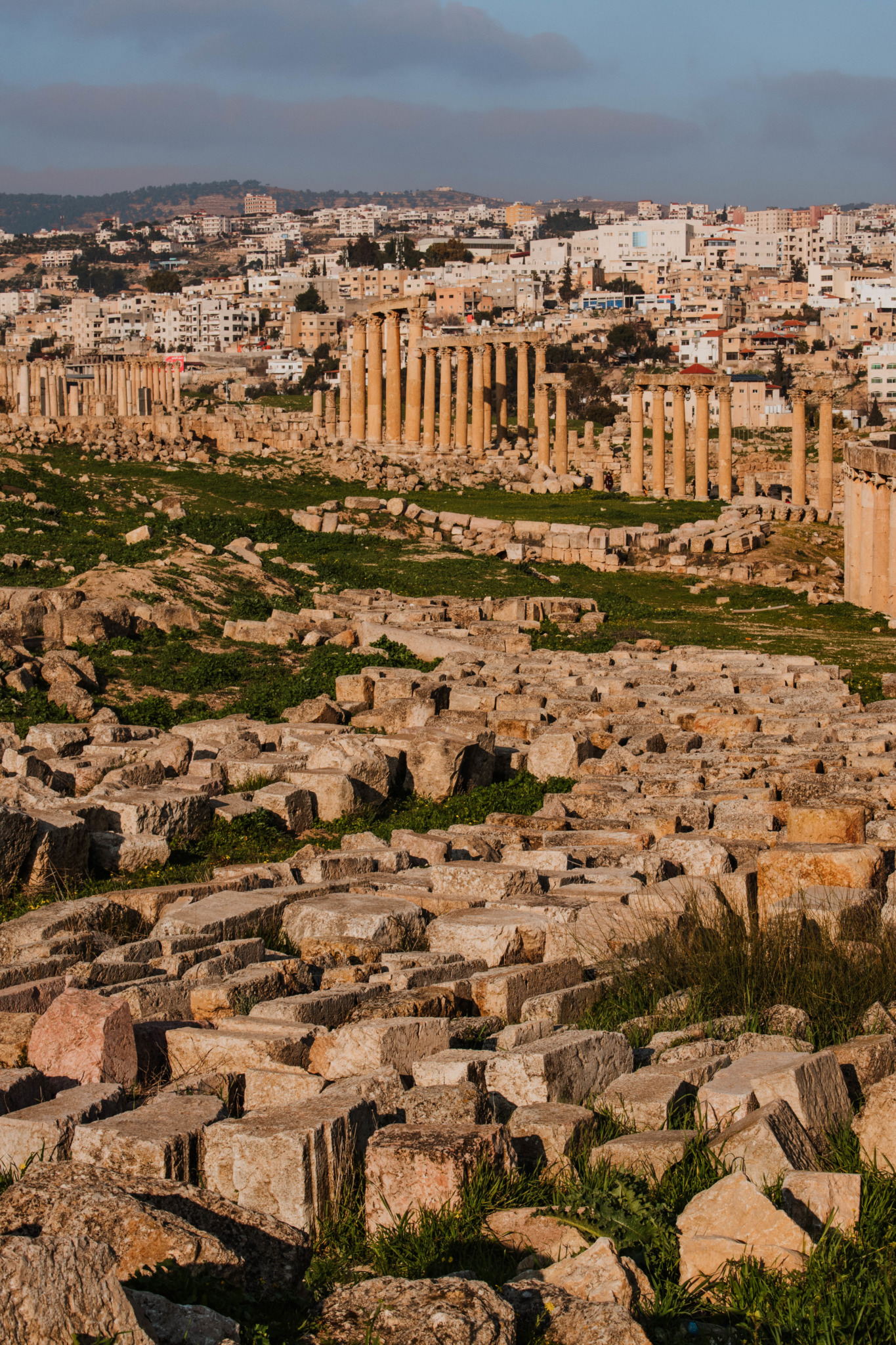

Earthquakes shook and destroyed much of the city, but the in the 2nd century AD Romans learned to add copper or tin between the columns which helped the structures not to fall over.
I definitely recommend a tour here as there's so much history to learn, our tour with Osama through Globus was incredible. We also had time to walk around and listen to the Jordan bagpipe band (not a typo!) in the Jerash theater. They played very familiar classics like Amazing Grace while I was shocked to see them outside of Scotland, I learned that the instrument's original roots are in the Middle East!
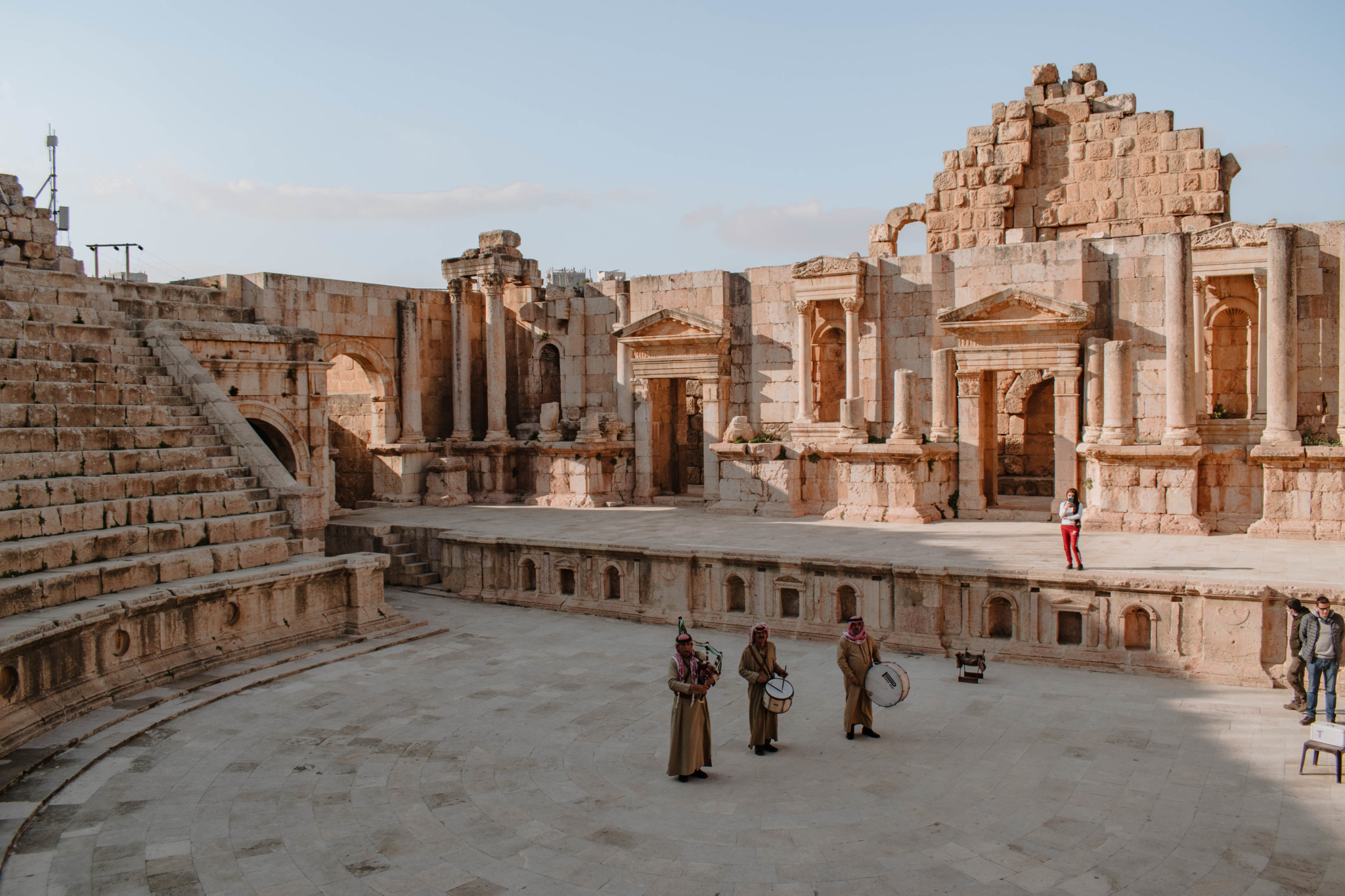
As we walked the grounds Michael stopped to play soccer with some kids. I love how accessible Jerash is, it perfectly mixes ancient ruins with modern day life, helping to picture what the ancient city really felt like.
We headed back to Amman to spend one more night in the Kempinski Hotel. For dinner we had a unique experience with a cooking class at Beit Sitti.
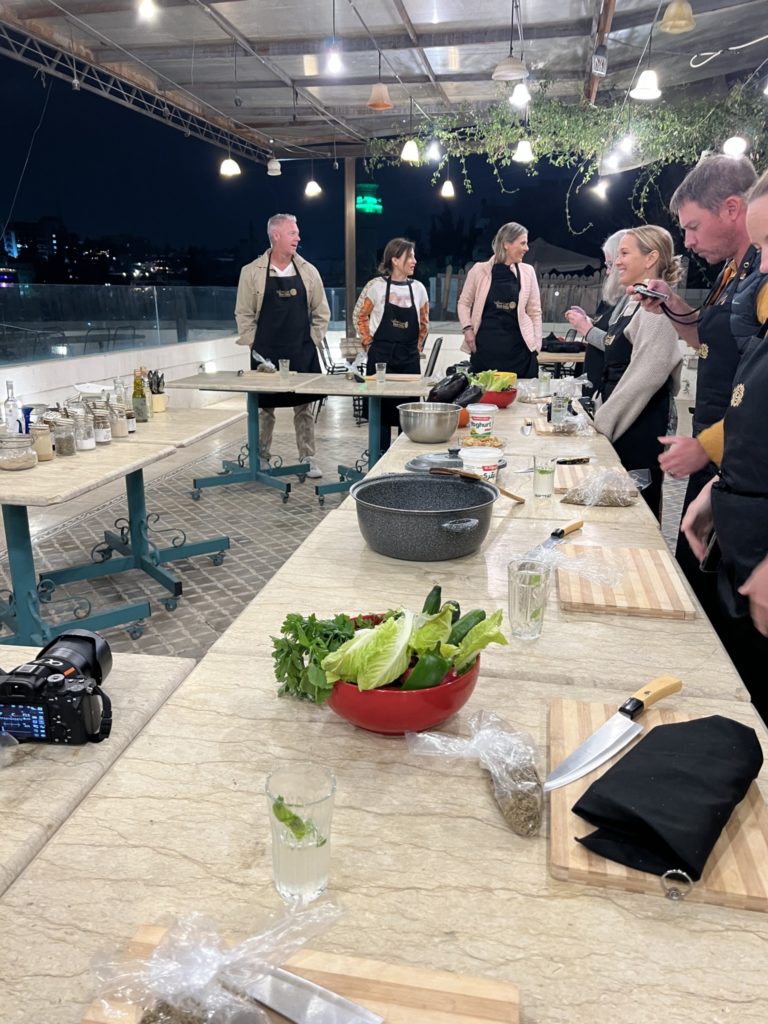
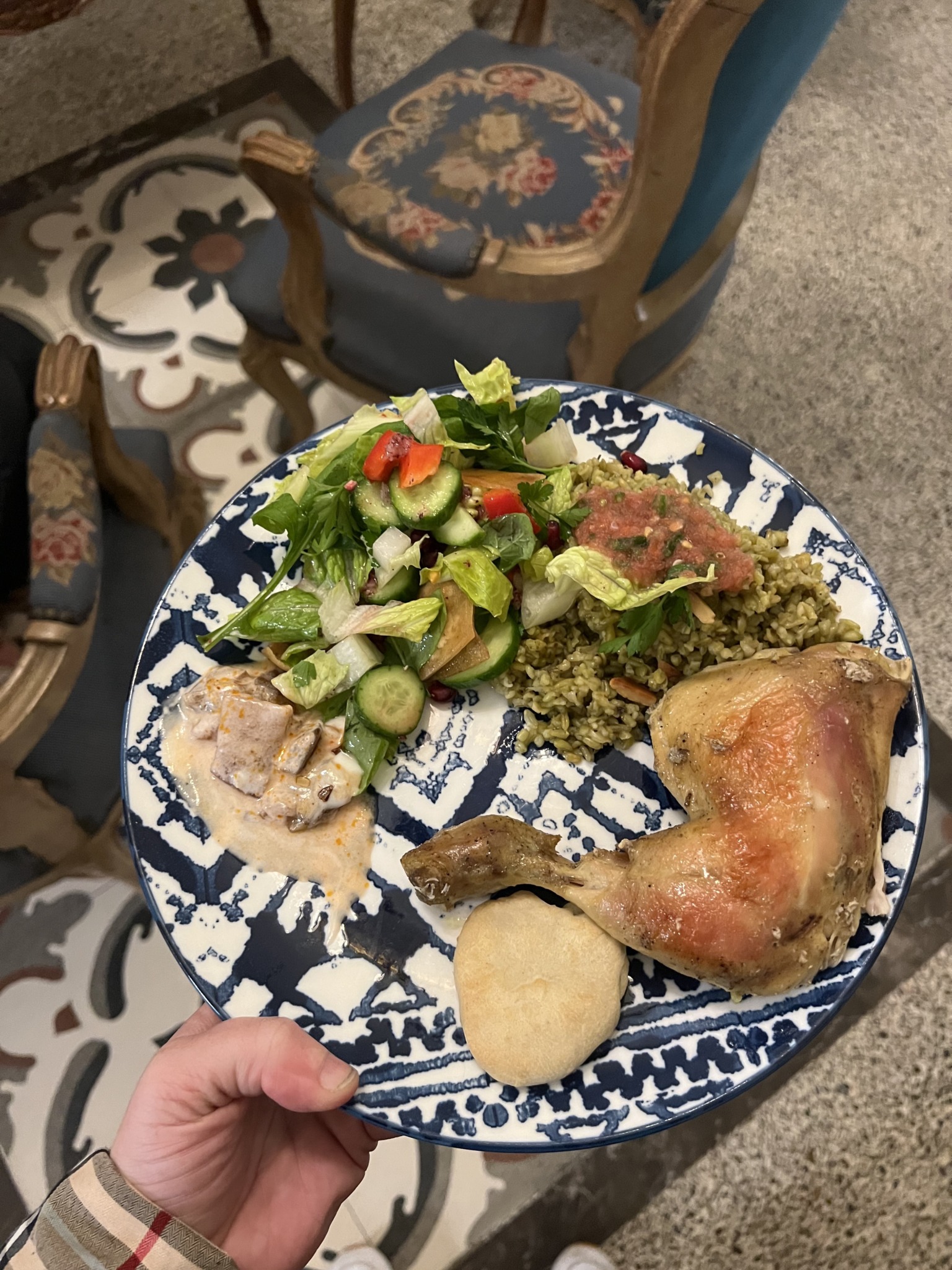
Beit Sitti means “Grandmother’s house” in Arabic, and it really felt like we were at Grandmother's house! Photos of their family hung on the wall and Maria, our instructor was lively and excited, showing us exactly how to cook while regaling us with stories.
I've never cooked traditional Middle Eastern cuisine before, and I learned a great deal, and also made a fabulous meal!
Day 3 – Wadi Rum
Heading to Wadi Rum feels like going to outer space. And I'm not the only one who thinks so, this also happens to be where they filmed the movie “The Martian” because it looks like the surface of Mars!
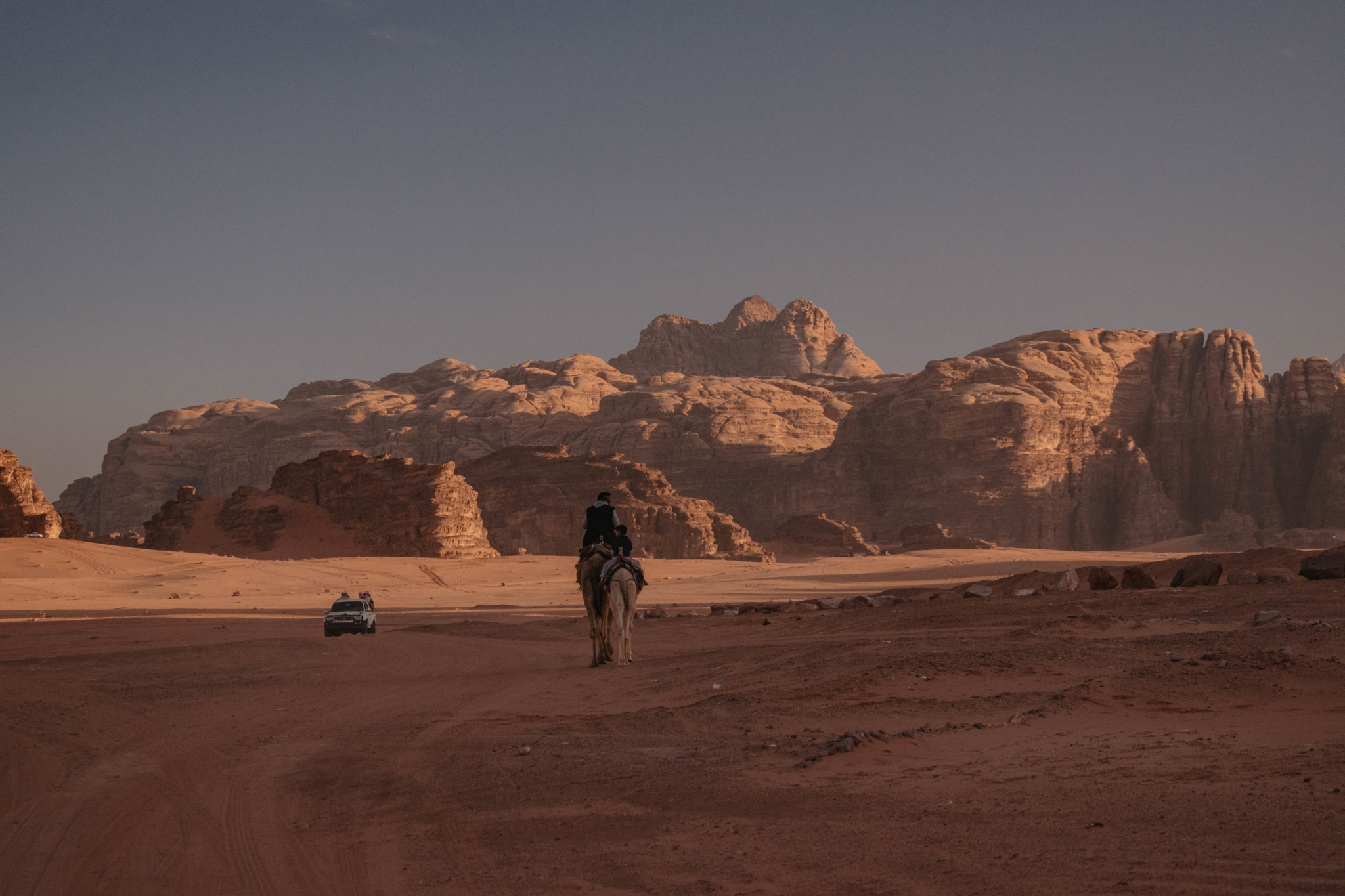
This is a desert valley made up of red sandstone and granite mountains. It's one of Jordan's most popular tourist destinations and was even used as a filming location for other movies like Lawrence of Arabia and Transformers: Revenge of the Fallen.
On our way to the desert Osama helped learn how to tie a “keffiyeh,” a Bedouin scarf.
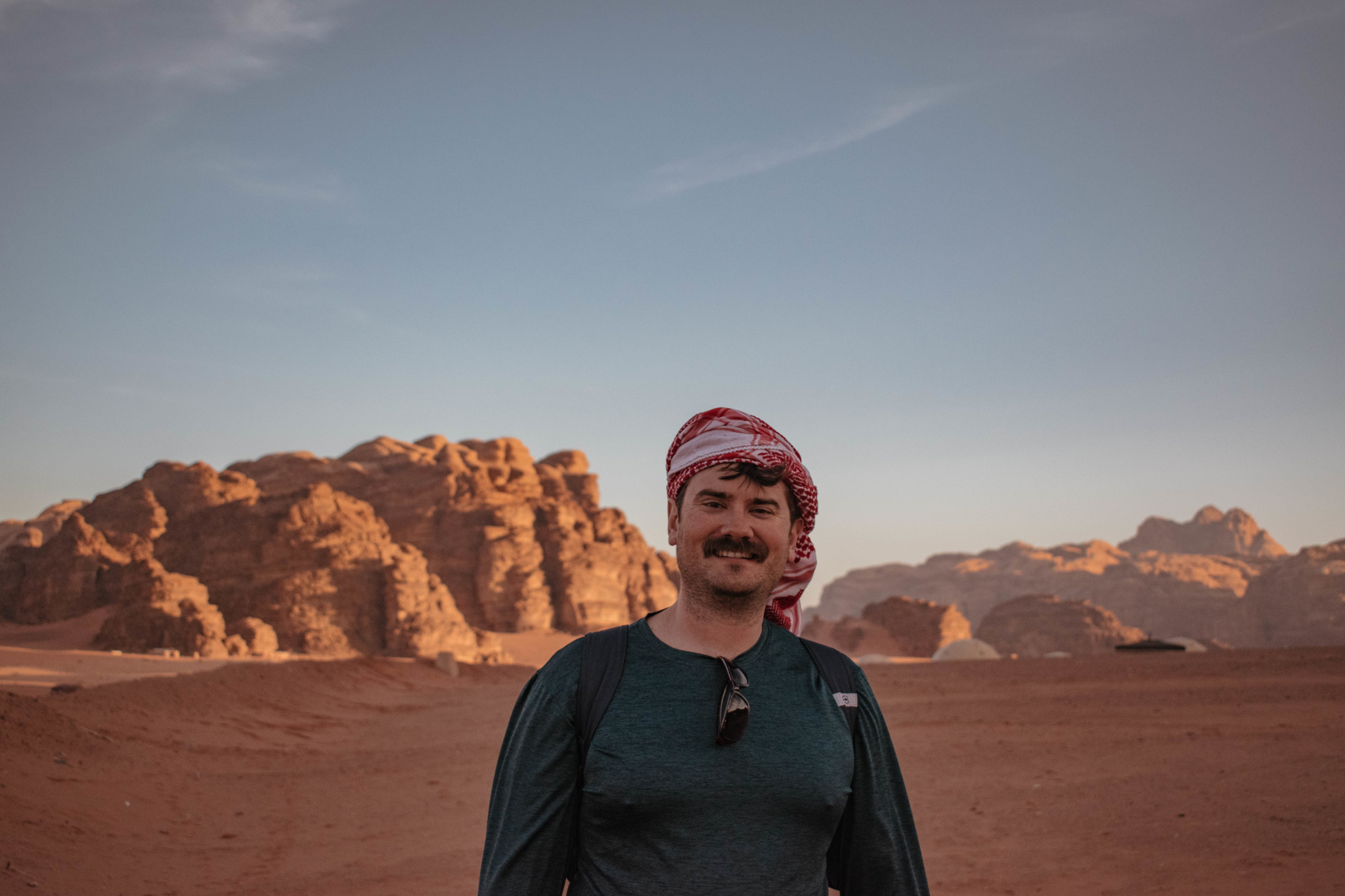
When we arrived we ate a buffet lunch at the Wadi Rum camp (you can spend the night out here if you'd like!) and then headed out for a four-by-four Jeep tour into the desert.
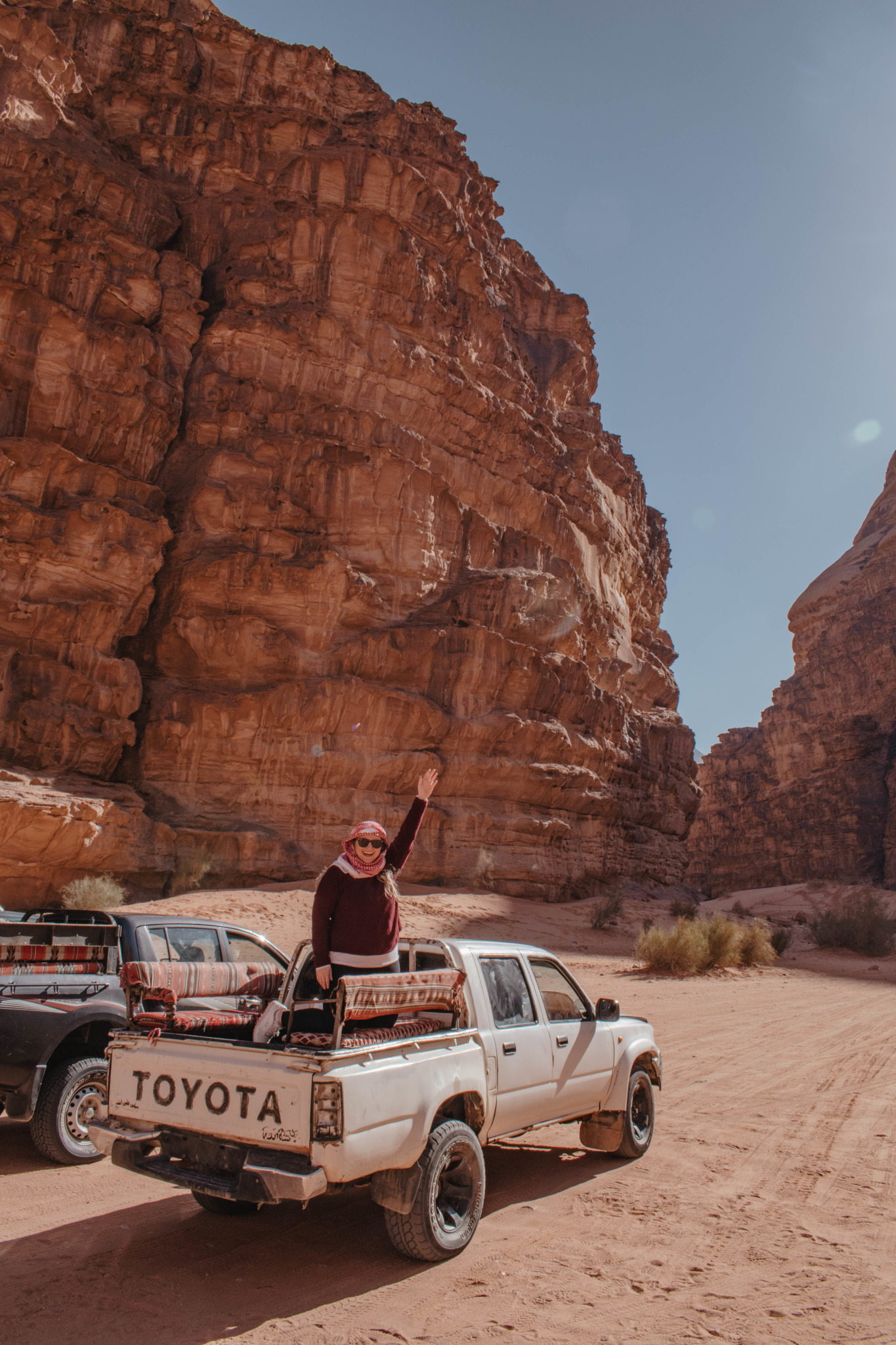
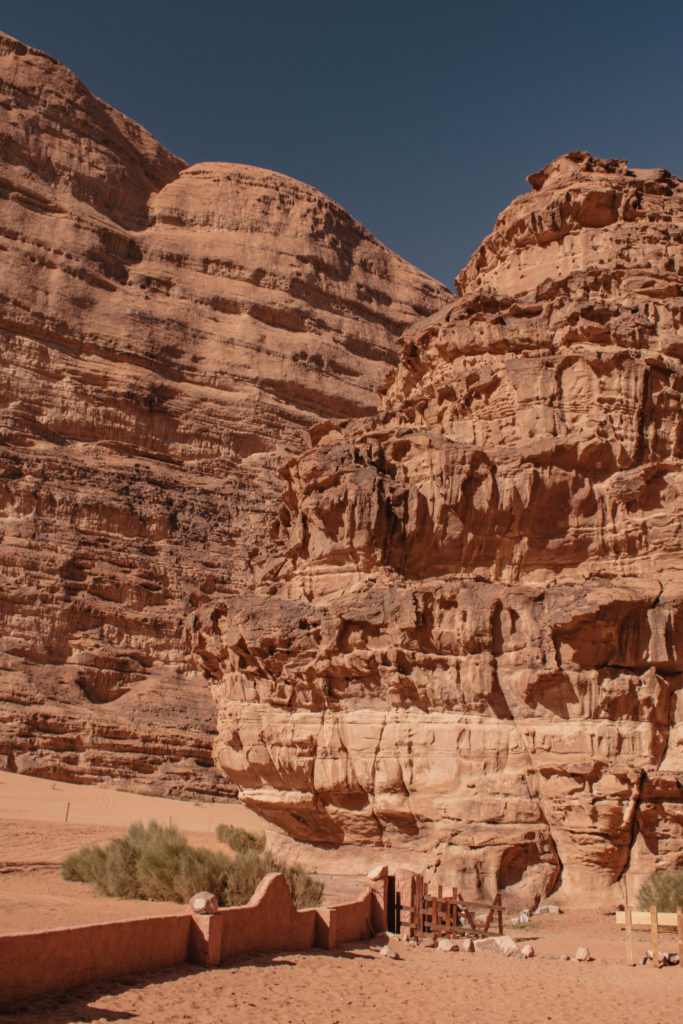
We spent a few hours touring around the incredible landscape, our hair whipping in the wind, as we gazed at the otherworldly landscape. You can tour sights like the red sand dunes, Lawrence’s Spring, the Khazali Canyon, the House of Lawrence, Abu Khashaba Canyon and Um Frouth Arch.
We hopped out of the jeeps and had the option to take a short, 30 minute camel ride to the Bedouin camp. If you've never done one, I recommend it! We did have a “frothing” camel since one of the females was in heat. Michael was the lucky one to ride this camel, and it was quite comical!
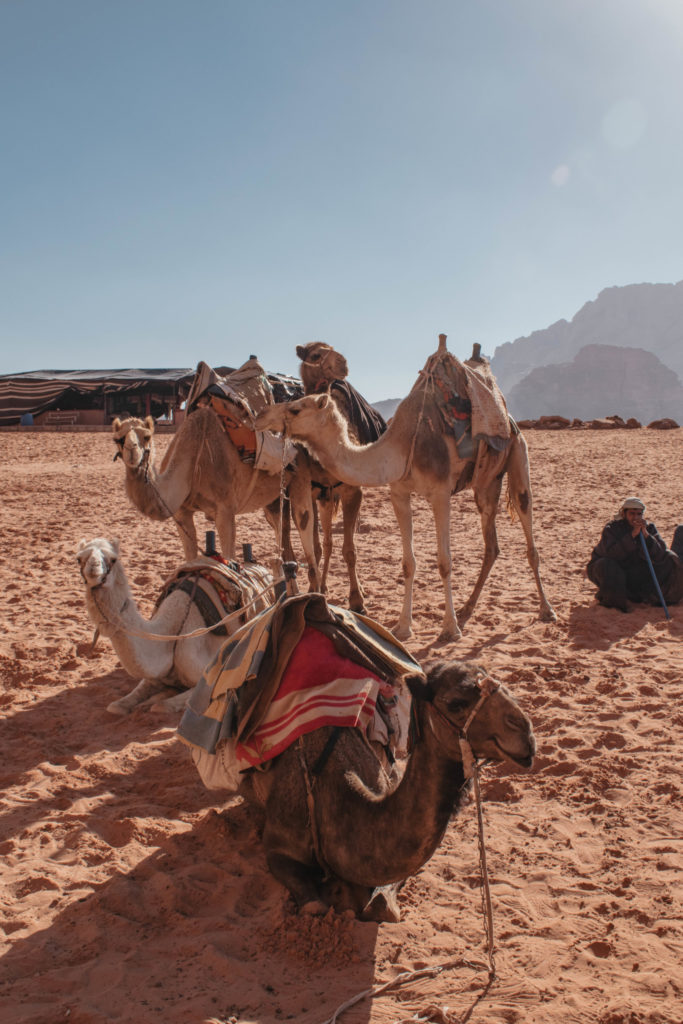

Camels are an integral part of the Bedouin nomadic lifestyle. Bedouin means “roamer” and this incredible part of the Jordan population traverses the landscape.
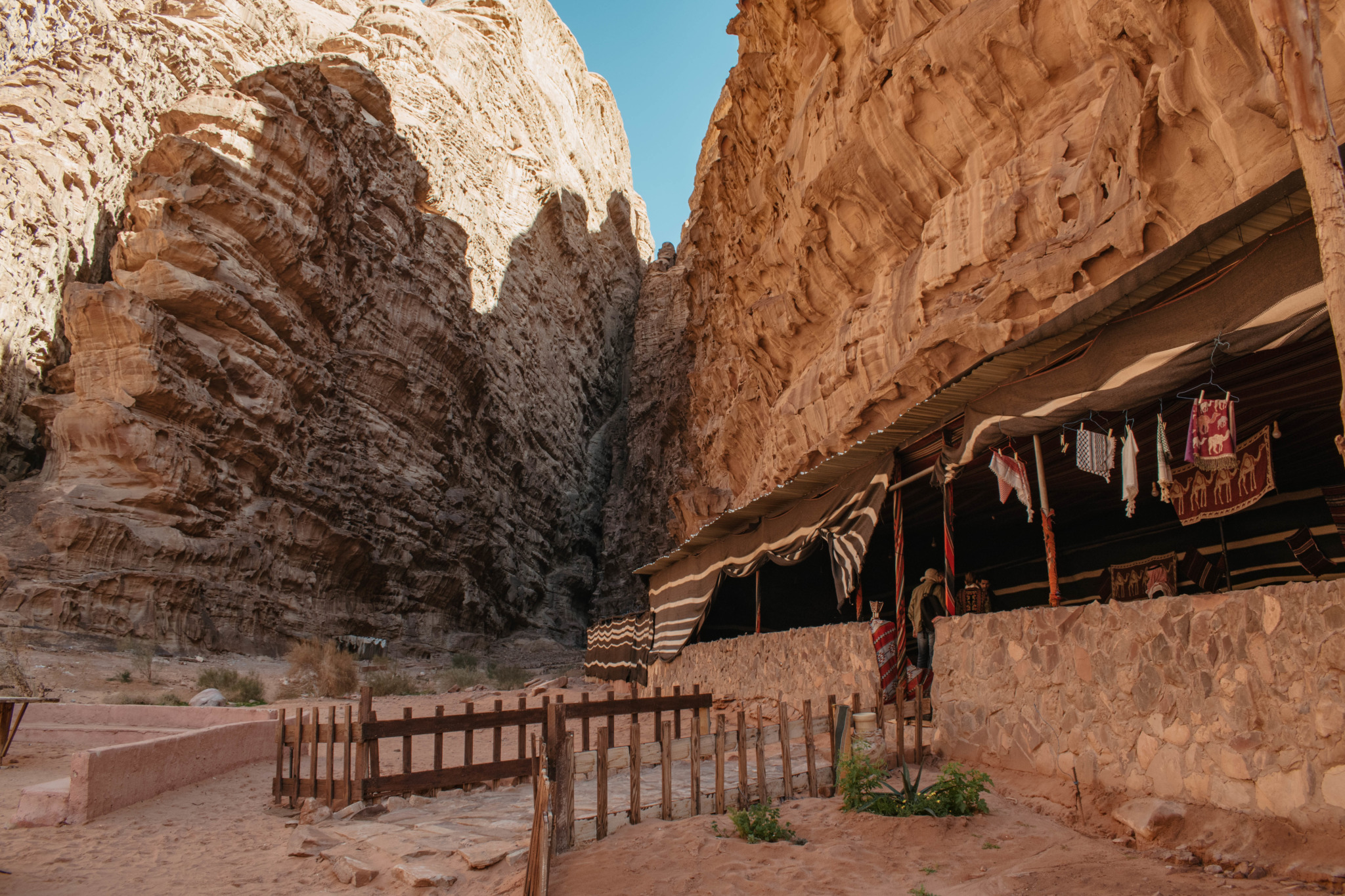
We then headed into a Bedouin tent for traditional tea. It was incredible to see how they live and use the land to sustain themselves. Then a Bedouin family invited us to show how they make bread. It was delicious! We dipped it in oil and spices and savored it among the towering red rocks. Hot and fresh off the fire we tasted the delicious bread and spoke with the family who welcomed us with such kindness.

After our long day, we made the drive to Petra so that we could get up early and hike to one of the world's wonders! See my full guide to Petra here!
For dinner, we enjoyed an incredible, home cooked dinner with a Jordanian family in Petra. We started off by drinking coffee, a ritual with lots of meaning. Each guest was handed a small cup of steaming coffee. It's tradition to start with a cup for each guest and customary to have 1-3 cups. If you have more than 3, you're telling the host the coffee is too weak!
Then we were taken to the kitchen for highlight of the evening: mansaf!
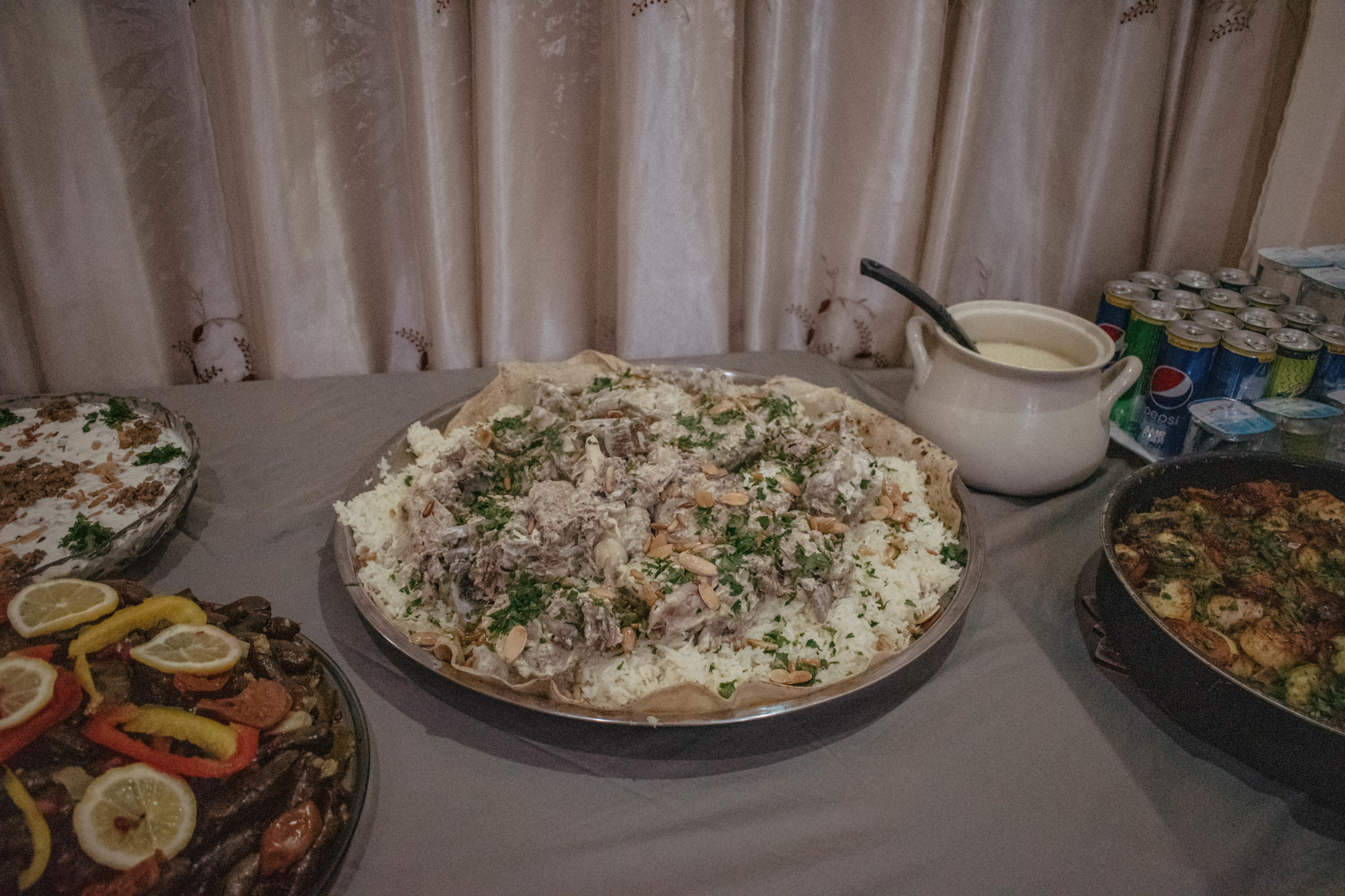
On our plane ride over from the USA we were told we must have this traditional Jordanian dish of mansaf, but ONLY if it was home cooked! We were in luck!
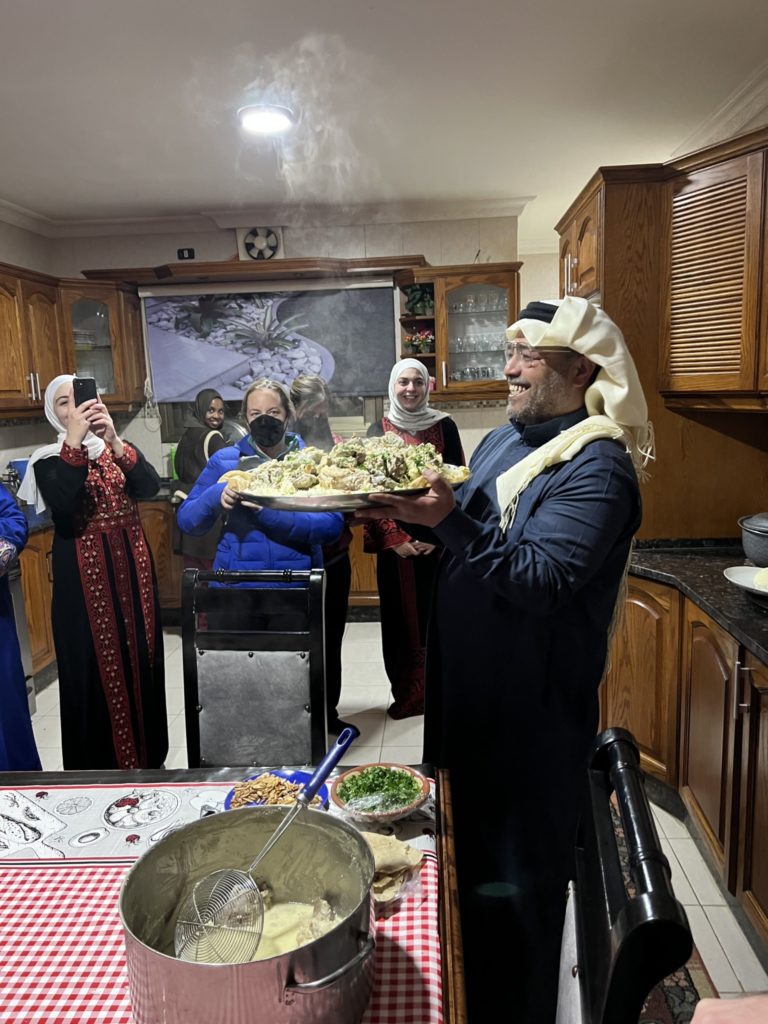
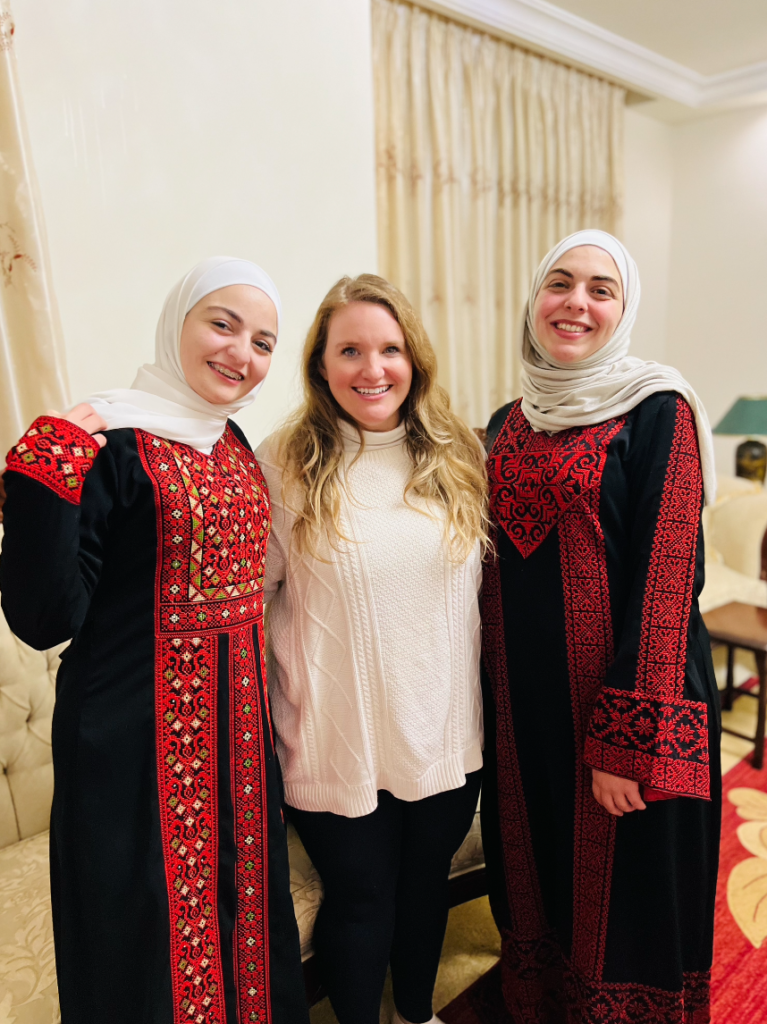
This tender lamb dish was decadent and scrumptious. Jordanians definitely encourage you to eat and drink to your fill! We had such a lovely evening chatting and learning about one another's cultures and traditions.
Where to Stay in Petra: Movenpick Resort Petra. It's a hike to get to Petra and this hotel is quite literally as close as you can get! This 5-star hotel is right by the Petra Visitor Center and Museum and is the perfect place to wake up, beat the crowd and head to the sight.
The buffet breakfast was particularly good and the interior of the hotel feels like a luxurious spa. Marble floors and delicate inlaid fixtures made for a beautiful place to rest.
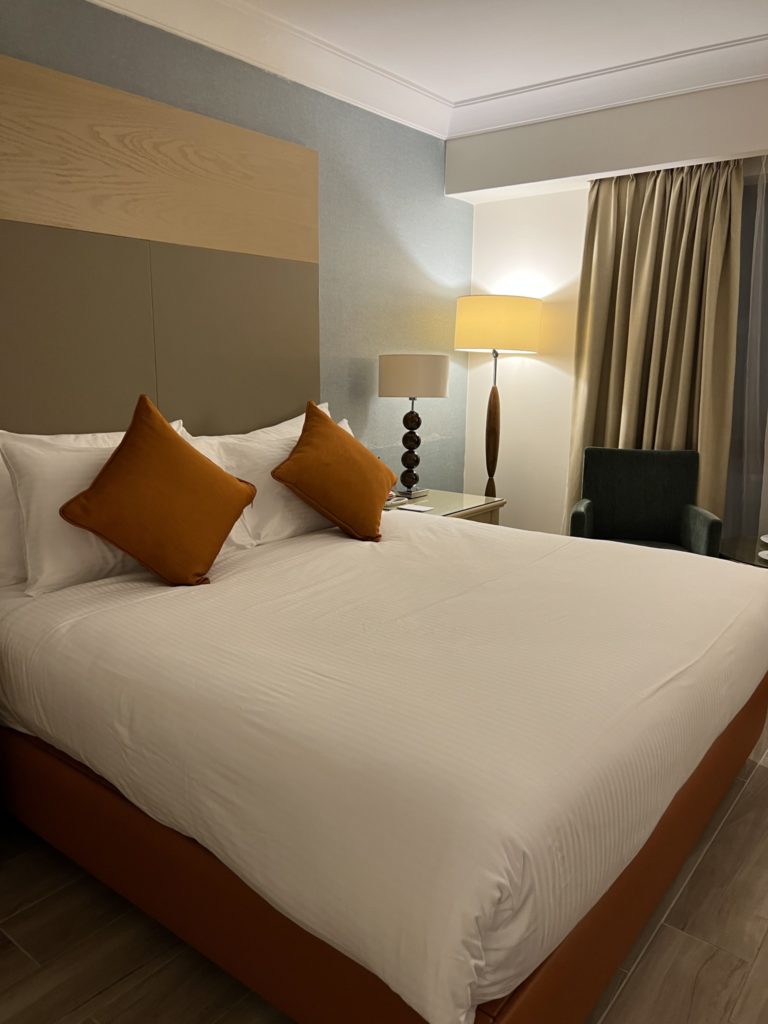
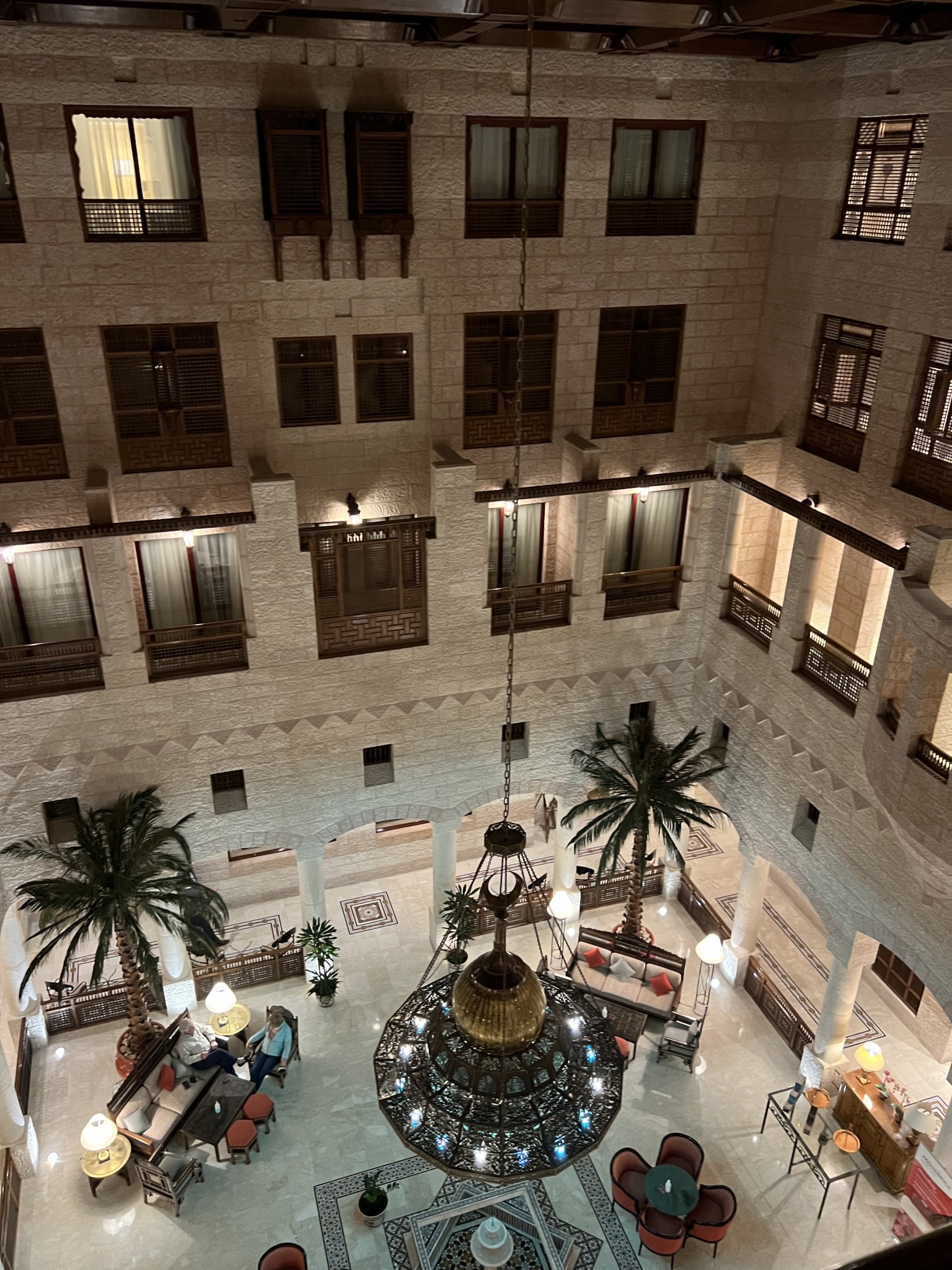
Day 4 – Petra
Petra is a magical place and one of the new wonders of the world and UNESCO World Heritage Sites. It has to be seen to be believed! You'll need at least one full day here to enjoy and relish in the history and awe-inspiring architecture.

I recommend you wear hiking boots or tennis shoes, lightweight clothing, and don't forget a hat and sunscreen.
See my full guide to Petra Here!
You can enter Petra through the Siq, a narrow crack in the sandstone that's bordered by walls that soar hundreds of feet into the air. As you walk through this enigmatic corridor, you'll be filled with anticipation for what lies ahead.
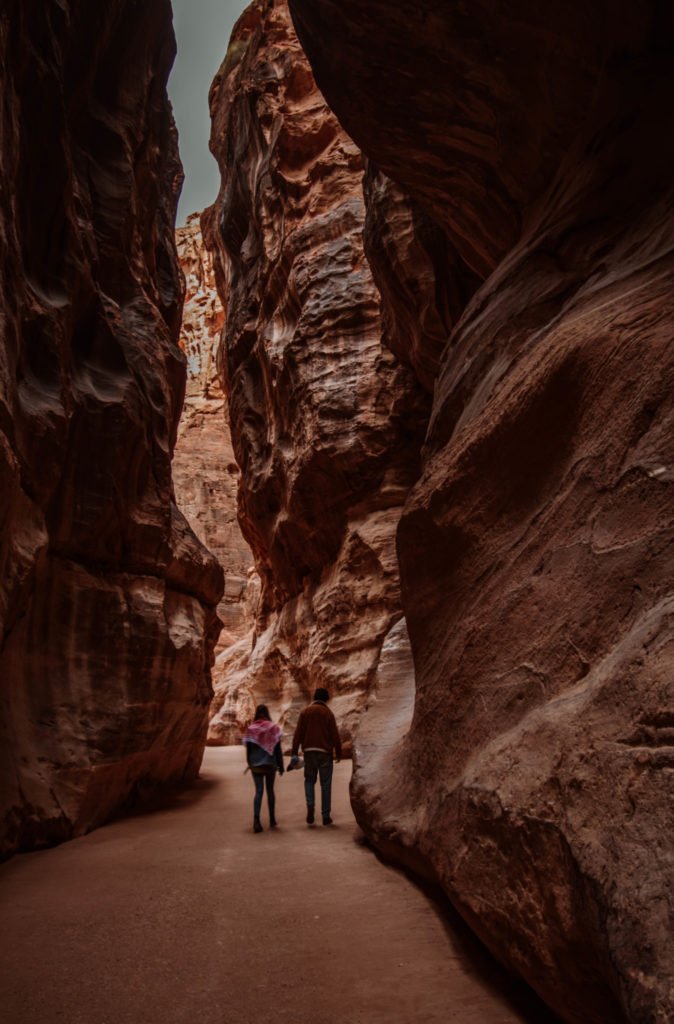
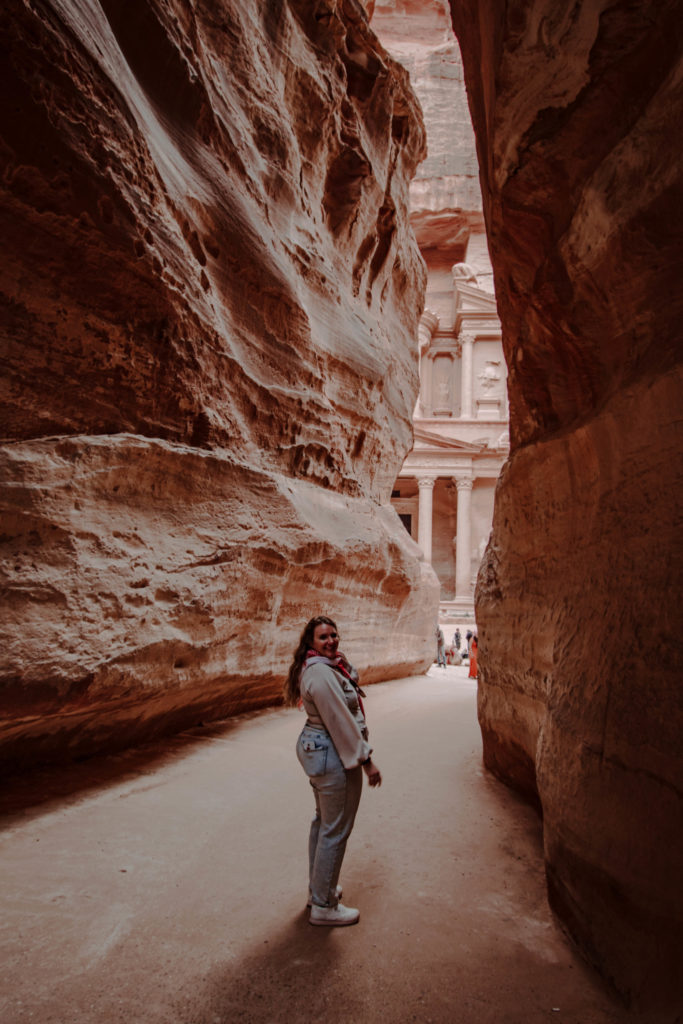
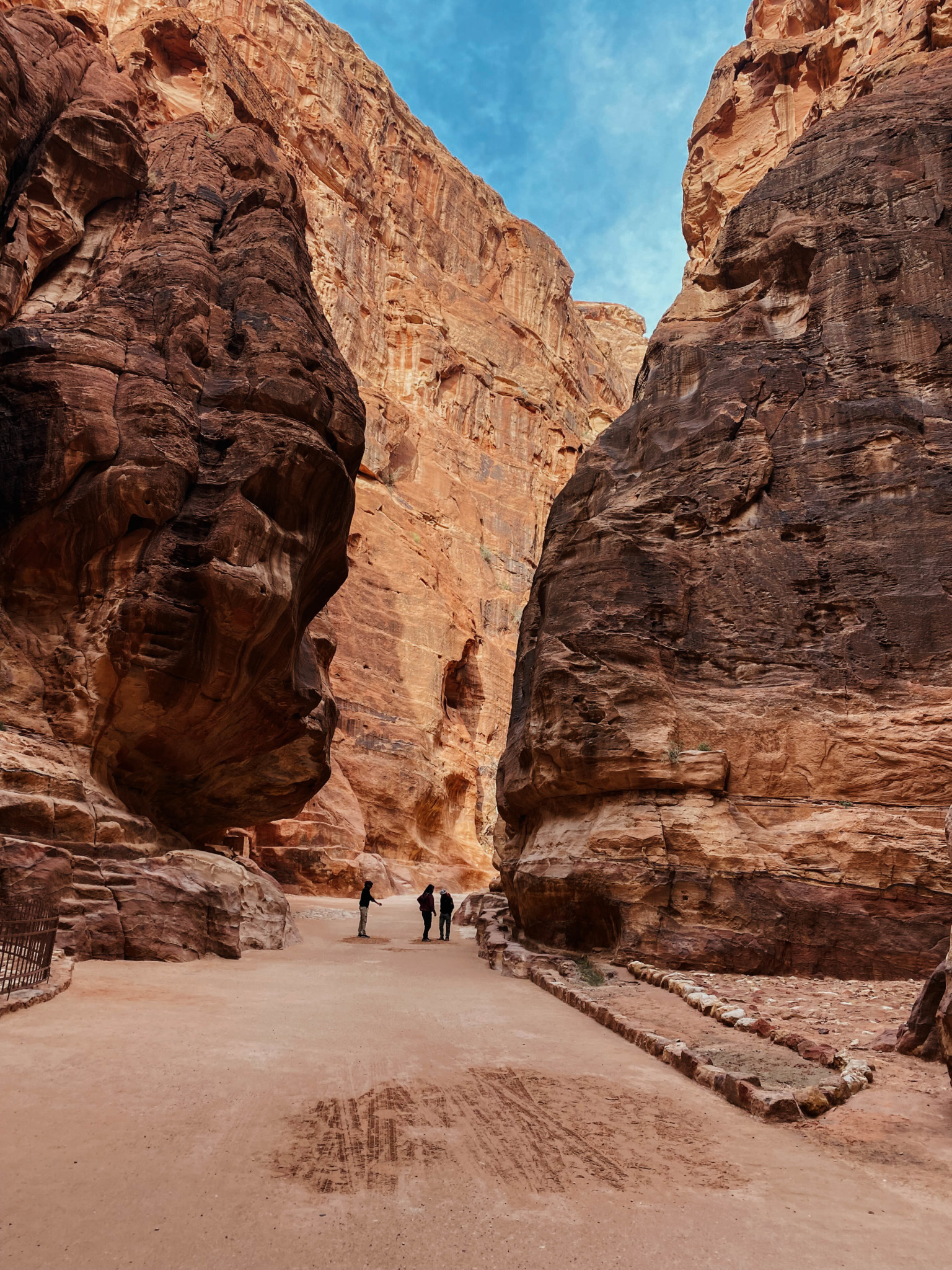
And then suddenly, you emerge into the breathtaking and very famous Treasury. It's no wonder that this is one of the most photographed sites in all of Jordan – it's absolutely stunning!

There is also a back entrance, a longer hike of 9 miles but it gives you an incredible view of Petra and the land surrounding it as well as the Monastery with no tourists!
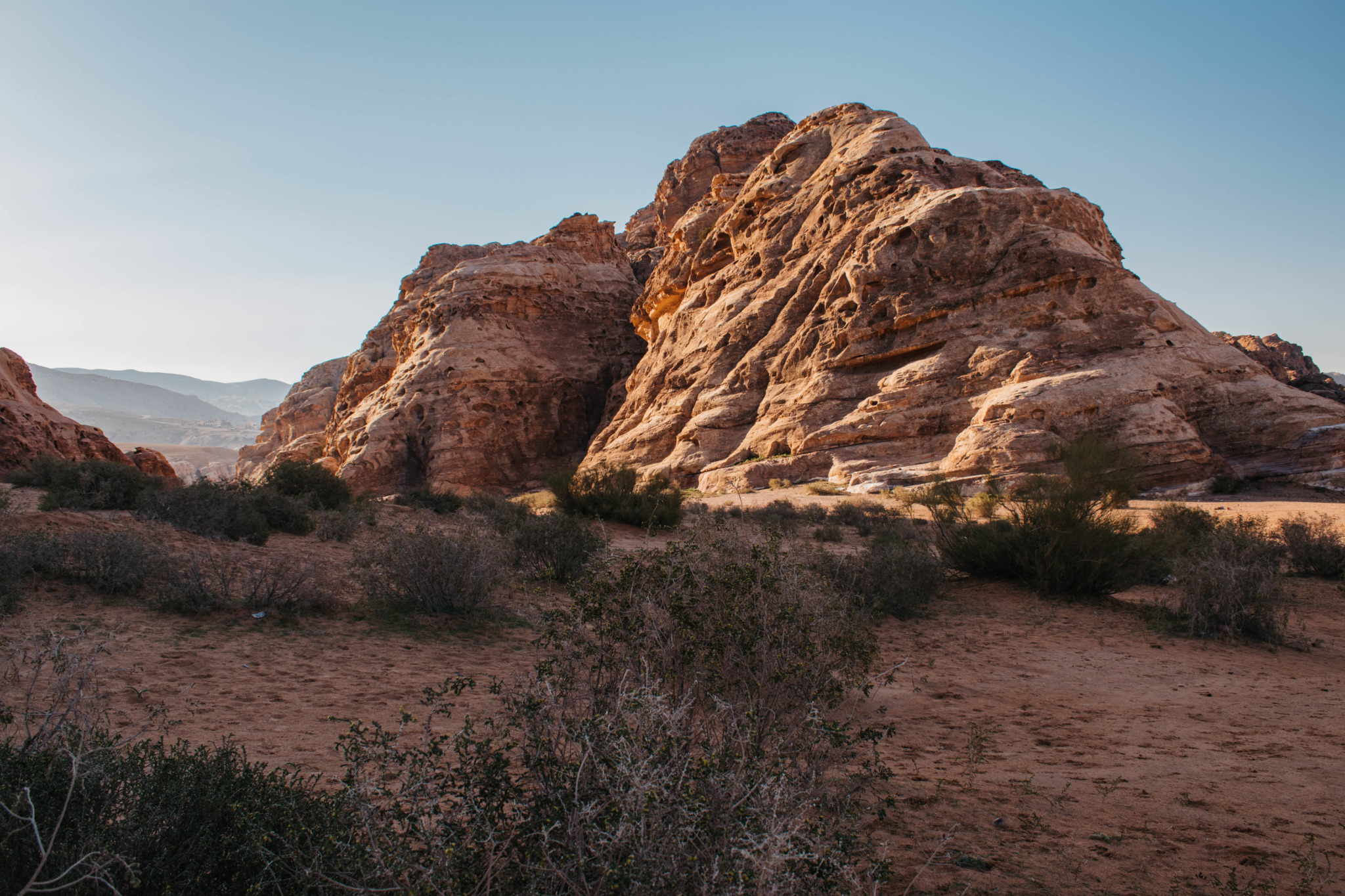
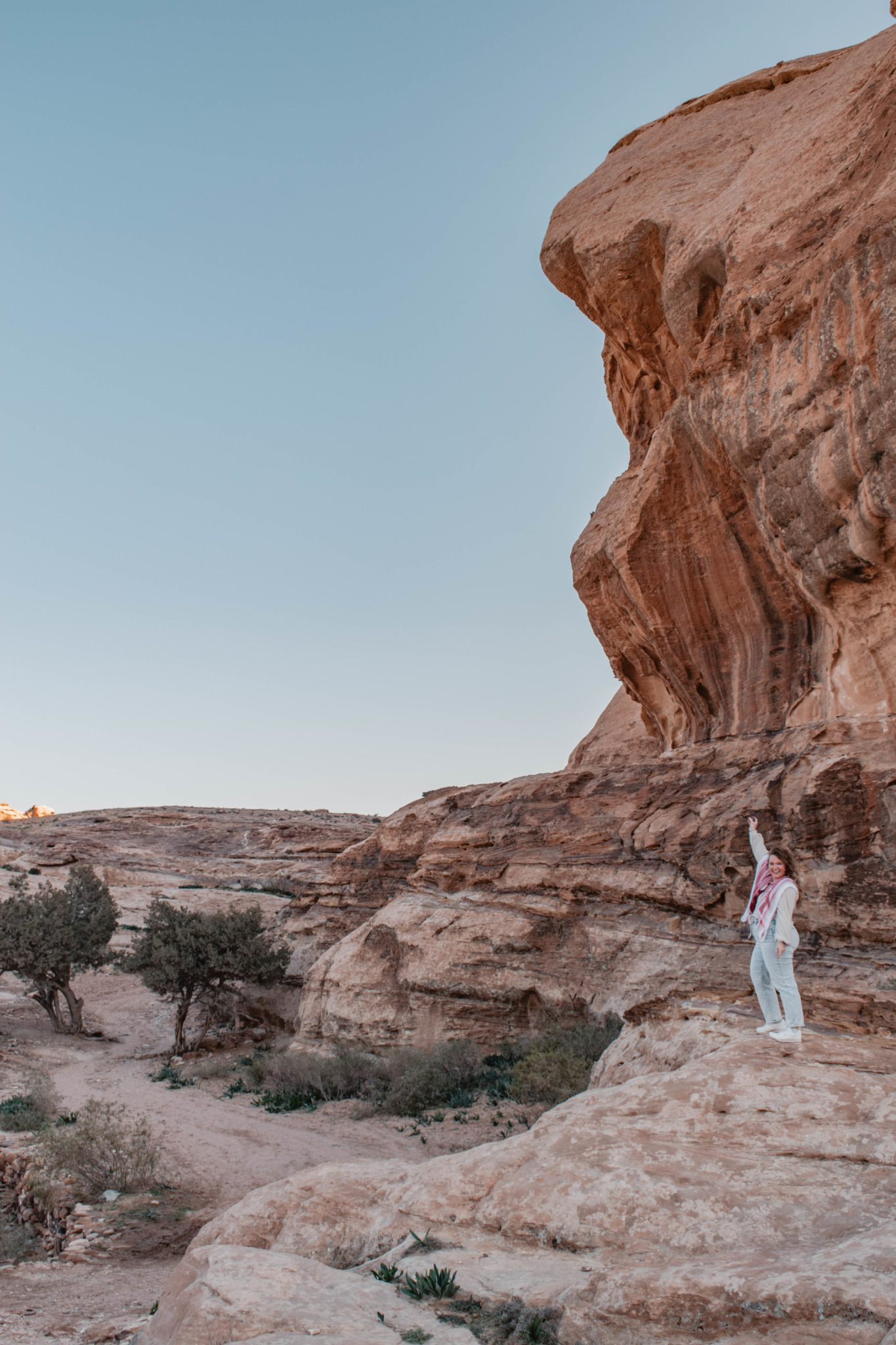
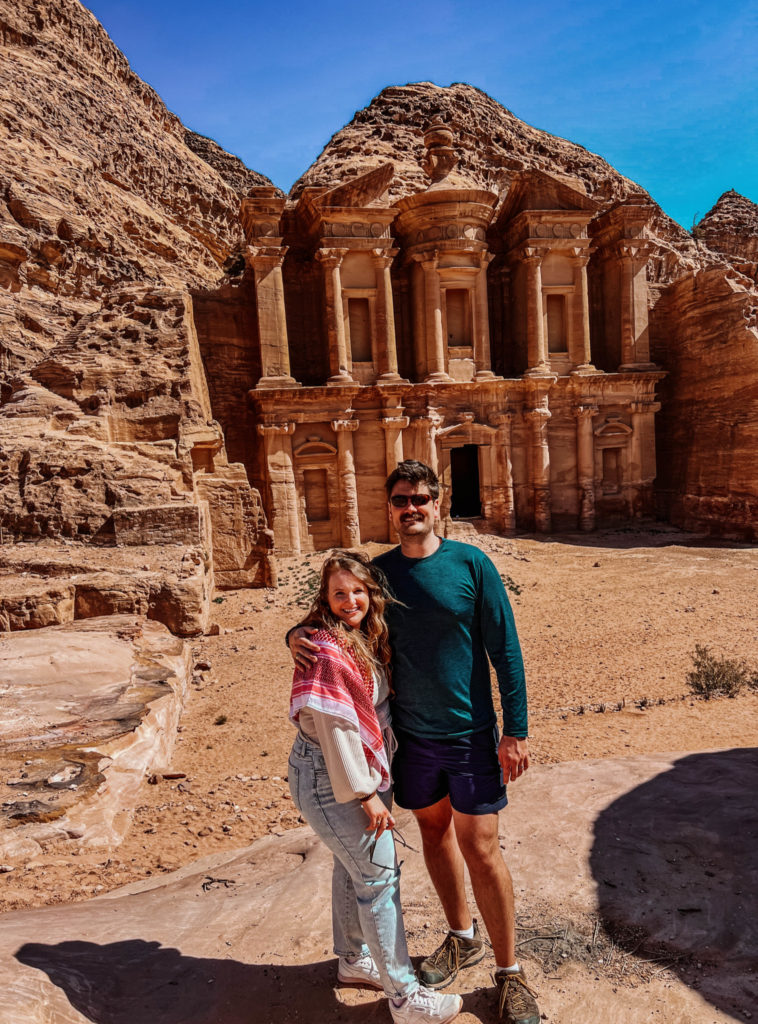
Petra was inhabited by the Nabataeans and later fell under Roman rule during their reign. But they were eventually driven away by an earthquake in 363 AD.
As I explored the incredible ruins of Petra, I was filled with awe and wonder at the remarkable architecture and history of this ancient city. The site is truly one of the world's wonders, as its spectacular stone temples and tombs have been preserved for centuries. Indiana Jones and the Last Crusade was filmed here and it's easy to see why this site was chosen!

PRO TIP: Don't just stop at the Treasury! Yes, it's a hike to keep walking al the way to the Monastery, but it will be well worth it. You'll have far less crowds and absolutely stunning views.
There are plenty of places along the way to grab a bite to eat or drink. And, if you're particularly tired after the miles of hiking, you can take a camel, horse, or donkey ride back. Now, they even have golf carts! It's 1.2km (about .75 mile) long to the Siq, the narrow gorge to the Treasury, but a total of 6 kilometers to the monastery (3 miles) so 12 kilometers (6 miles) round trip.

I spent several hours hiking around Petra, marveling at the incredible architecture and history. Save some energy because you must come back at night for “Petra by Night.”
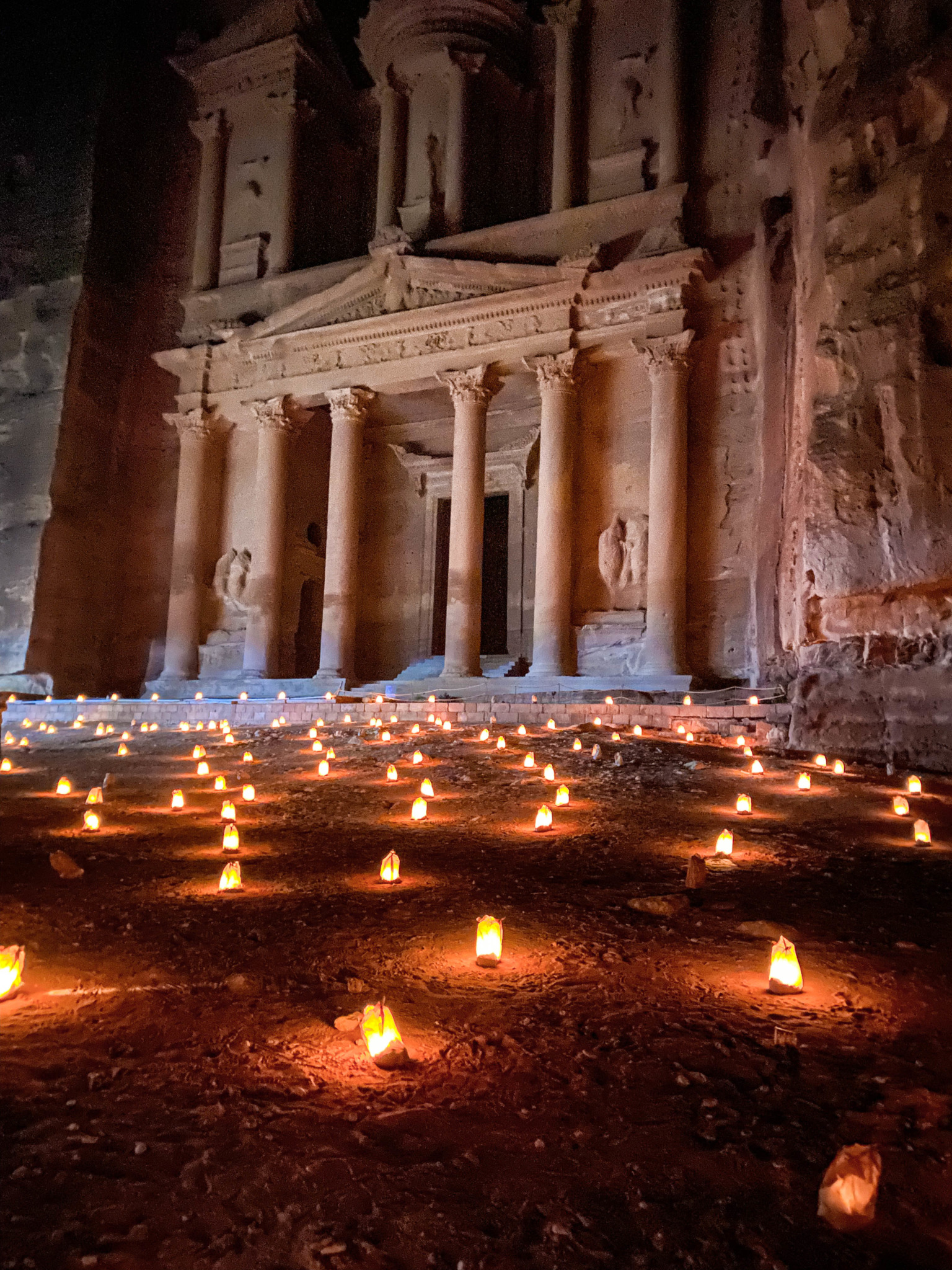
We had a short break in between where we explored the visitor's center and museum, got a bite to eat and rested our feet before an additional hike back in.
White paper bags filled with sand and candles are the only sources of light that warm the red stone walls. As you meander down the narrow gorge the bright stars above you beckon you down to the music.
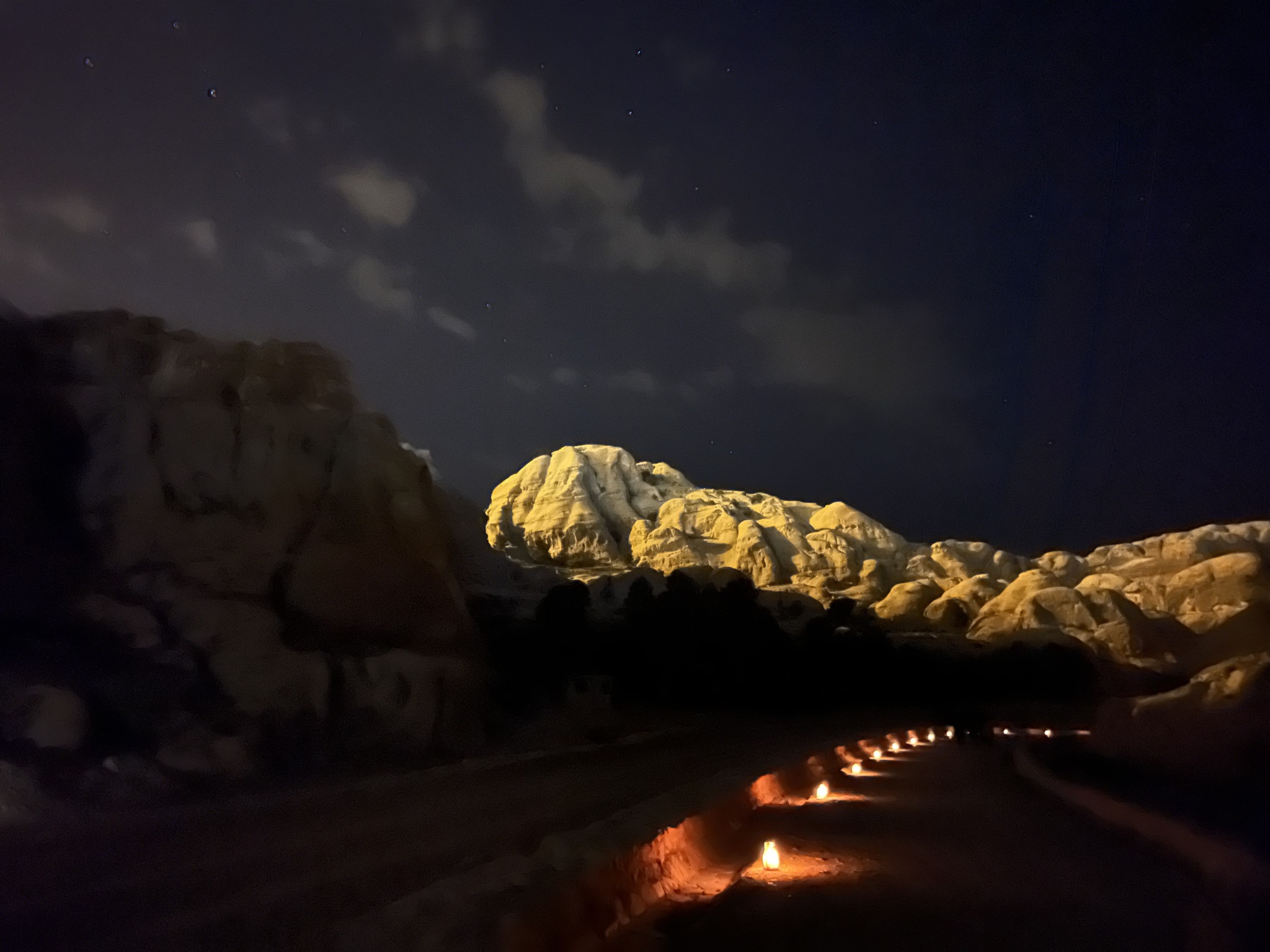
From the visitor center to the Treasury, more than 1,000 candles illuminate the path. The Treasury is lit up as the Bedouins play music for around 40 minutes before being told a brief history of Petra's development.
Not only is Petra a wonderful place to see, the history of the Nabataeans is fascinating.
Day 5- Petra – Kerak Castle – Wadi Mujib – Dead Sea
If you have extra time in Petra check out “Little Petra” also known as Siq al-Barid. It's an archaeological site located north of Petra and the town of Wadi Musa with smaller versions of buildings carved into sandstone.
We drove from Petra on to the Dead Sea and made some stops along the way. First was the Crusader Castle or Kerak, which was built in 1132 A.D.
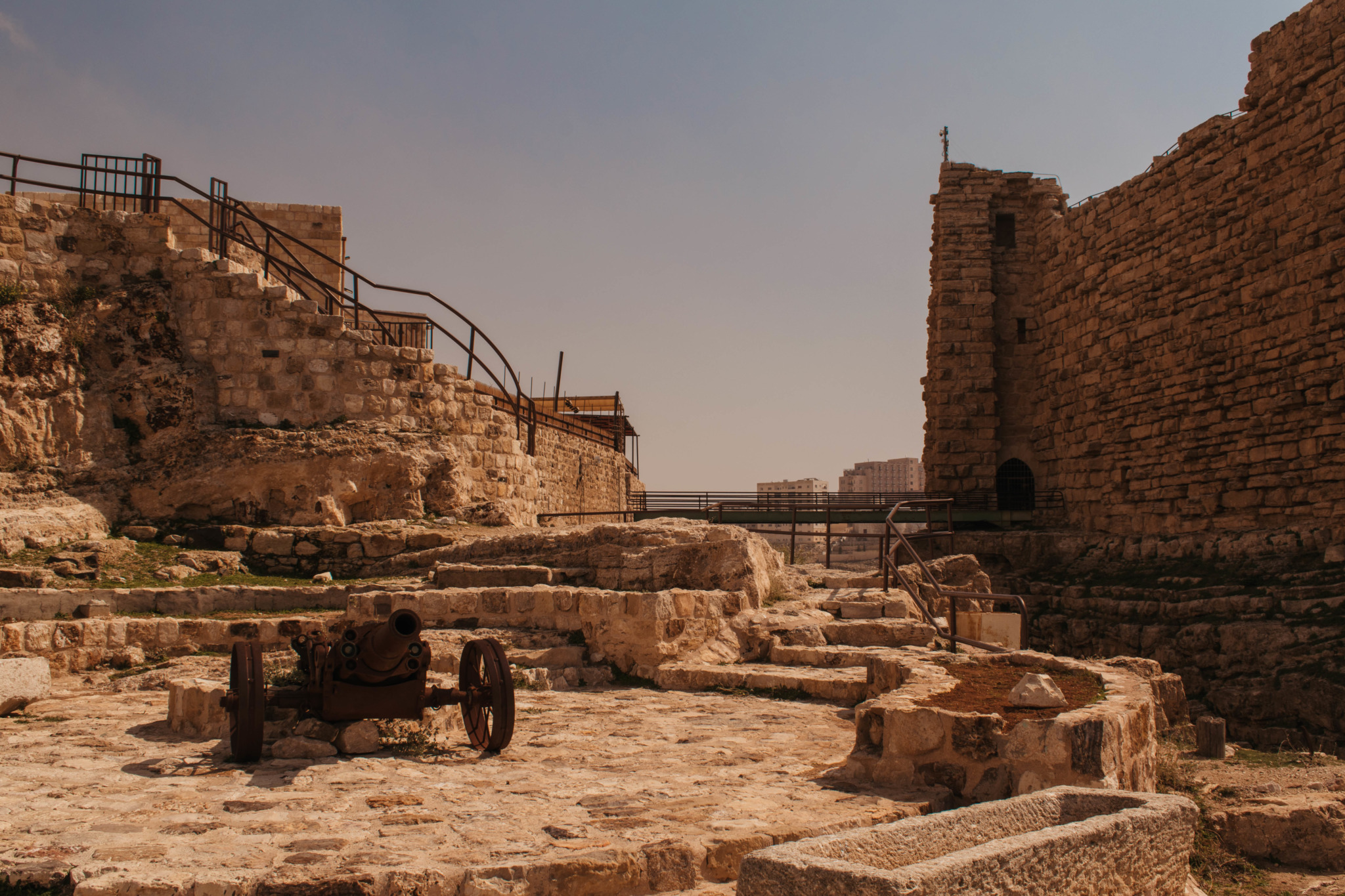
This fortified castle is one of the largest in Jordan, and gives stunning views. Built like a labyrinth, the castle held prisoners and you can walk through where they were held.
After exploring the castle we had lunch and then made our way to Wadi Mujib.
We had a quick stop at the “Grand Canyon of Jordan” with sweeping views and the wind whipping the cavernous gorge as it carves it's way down the the Dead Sea.
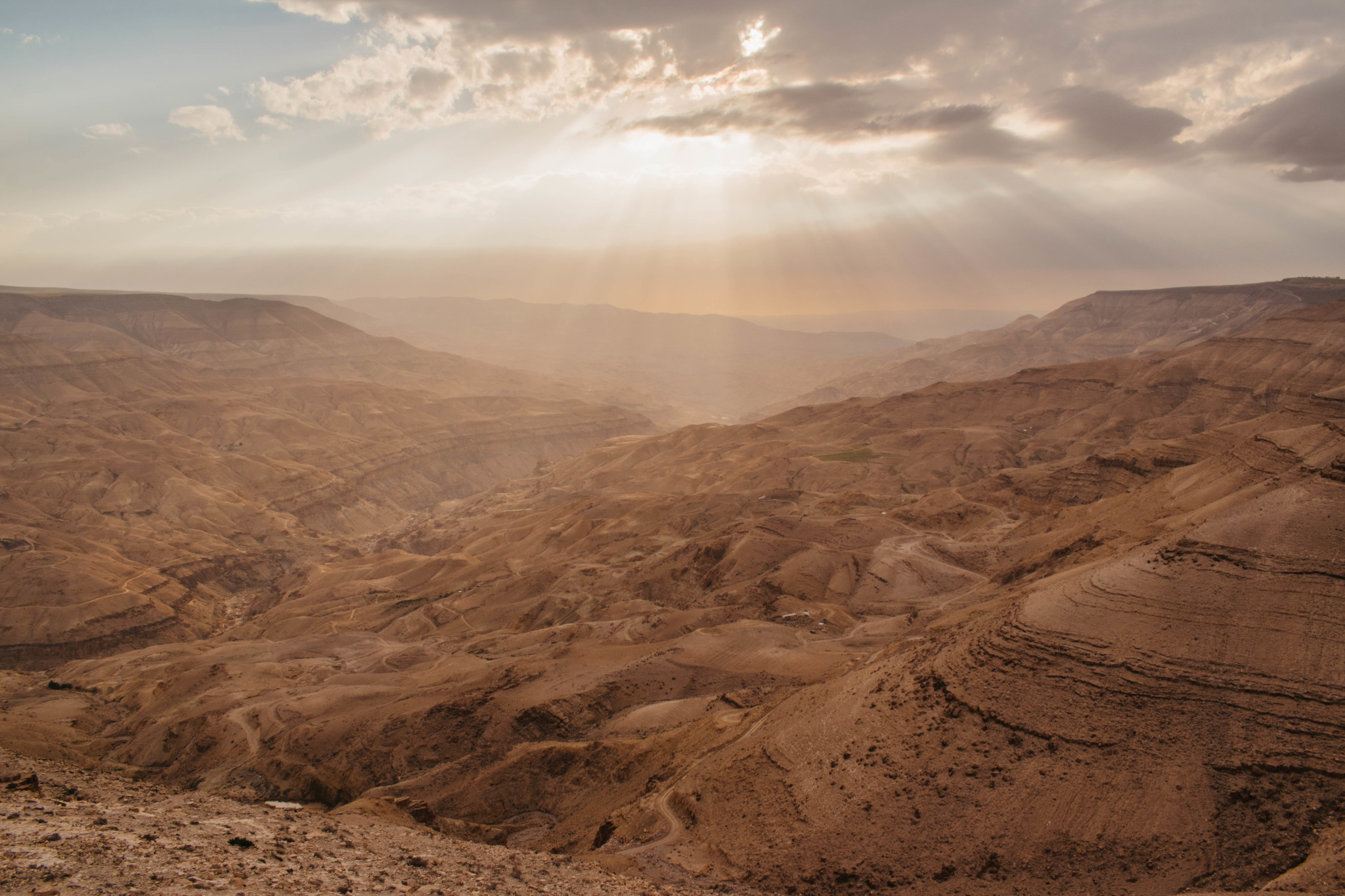
We arrived just in time for sunset and a dip at the lowest place on earth, the Dead Sea!
I absolutely love how Globus organized our Dead Sea experience. We stayed at a lovely resort: Movenpick Resort and Spa at the Dead Sea which gives you private beach access. Having gone to the Dead Sea in Israel, I can say this is a truly enjoyable experience.

So, why is it called the Dead Sea?
Well, because the water is 34 salinity, super salty, nothing lives in it! But this also means you can easily float in it! You'll literally feel like a cork bobbing on top of the water. It's a sensation unlike anything else I've ever experienced. You can see me float in the Dead Sea here!
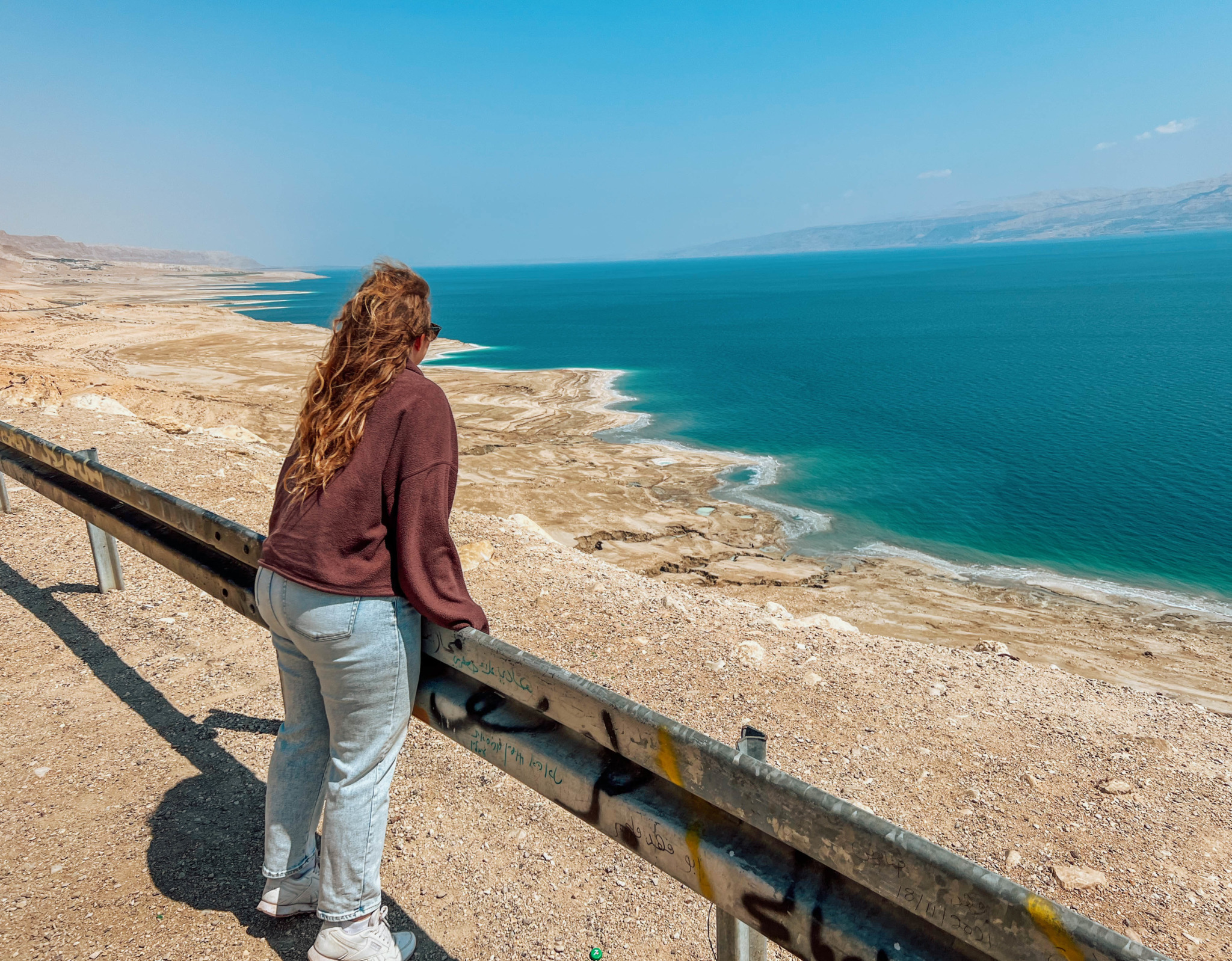
Top tips for the Dead Sea
DO NOT: dive, splash, or get the water in your eyes. It will burn. I would also avoid getting it in your mouth. I recommend about 20 minutes at a time for a float because it can cause dehydration.

It's a bit tricky getting into the water as there are salt formations that can be tough on your feet. if you have water shoes or flip flops you can opt for that, or just walk in carefully like I did.
But don't be alarmed! The minerals are very good for your skin. I also recommend lathering up with some Dead Sea mud and enjoying the ritual of washing it off in the water. My skin felt so smooth after!

Where to stay at the Dead Sea: As I mentioned above, we stayed at the Movenpick Resort. This gorgeous, large hotel greets you with sweet tea and comfortable, spacious rooms. The highlight, of course, is your access to the Dead Sea. There are lifeguards here to help you enter the water – this was especially nice to not hurt my feet on the salt formations.

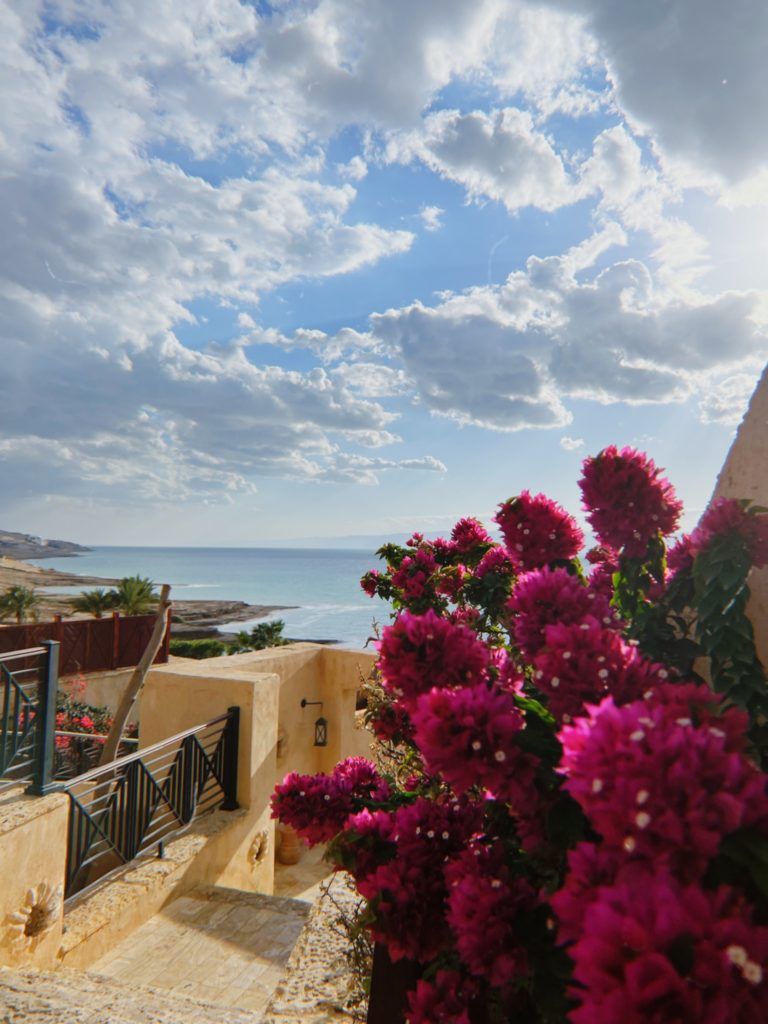
The resort offers pools, a spa, and many restaurants on the property. We had pina colodas and enjoyed sunset at the beach bar.
Day 6 – Dead Sea & Religious Sites
In the morning we had time for another dip in the Dead Sea, so mud up and go for it!
Then we headed to some of the most moving religious sites. I was excited to see the place where Jesus was Baptized and Moses saw the Promised Land, but it was really an emotional experience.
Whether you're religious or not, we've grown up with stories from the Bible and its historical significance has touched the world. To see it come to life was truly an experience. I was raised Catholic and going to these places and hearing the descriptions is unlike anything I've ever experienced before.
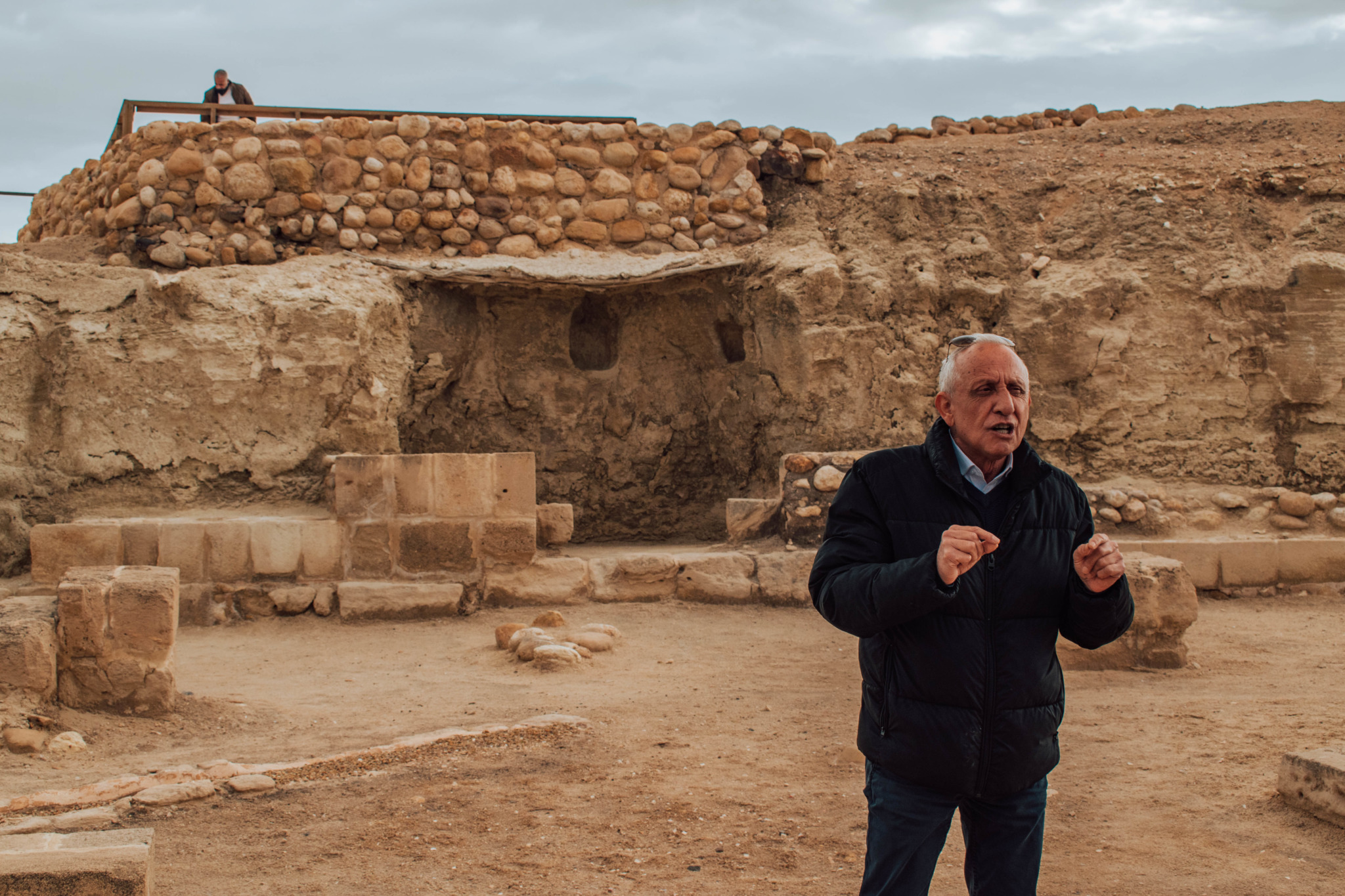
Our guide, Rustom Mkhjian, is the esteemed Director General of Bethany Beyond the Jordan, who shared an outpouring of love and enthusiasm for these sights. We saw the spot where Elijah was taken in to heaven in a chariot of fire, the spot where John the Baptist lived and performed miracles, and the place where John baptized Jesus in the Jordan River.
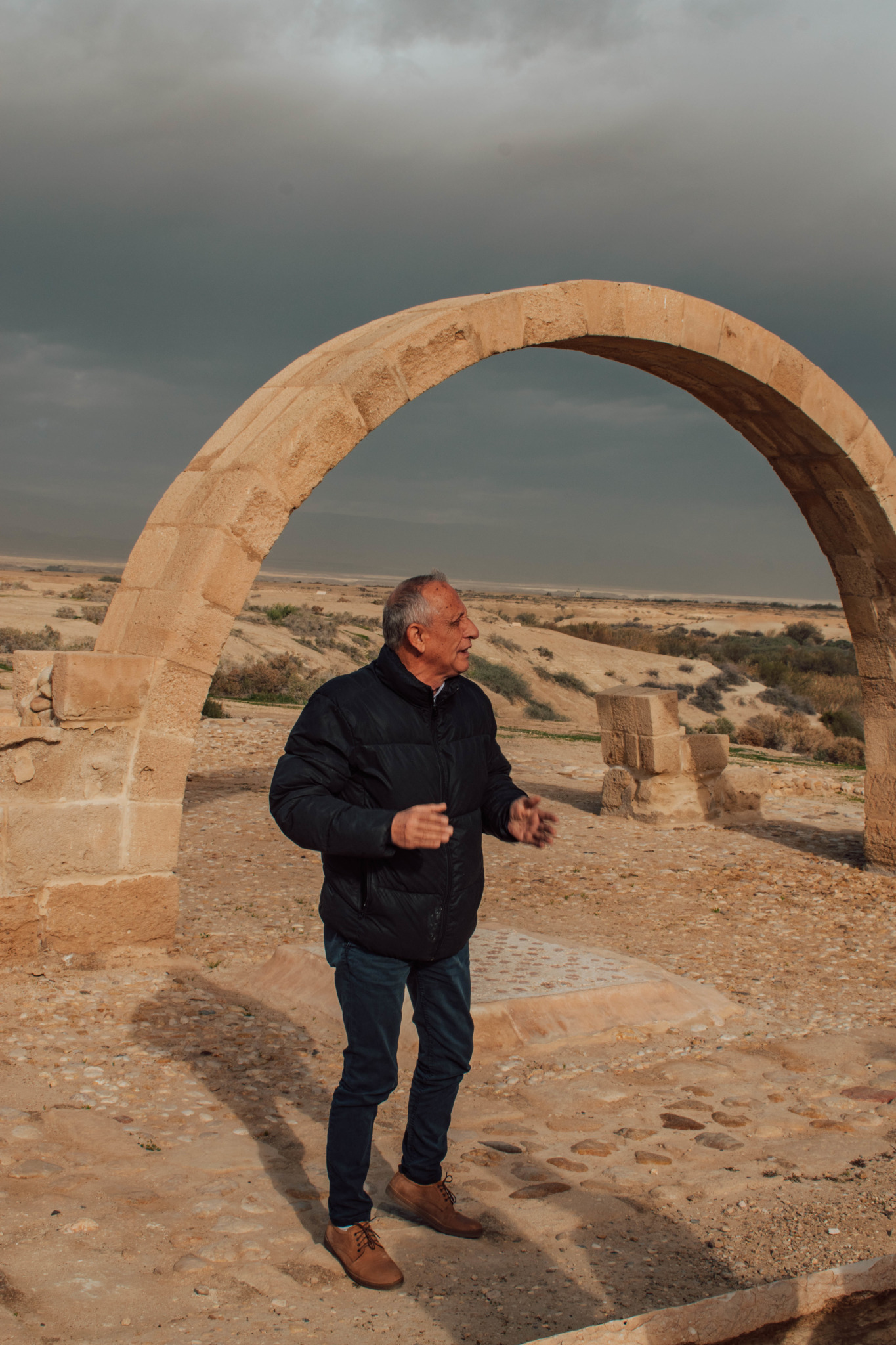
The baptism site of Jesus was particularly moving, and because there weren't any crowds we got to go down and touch the water.
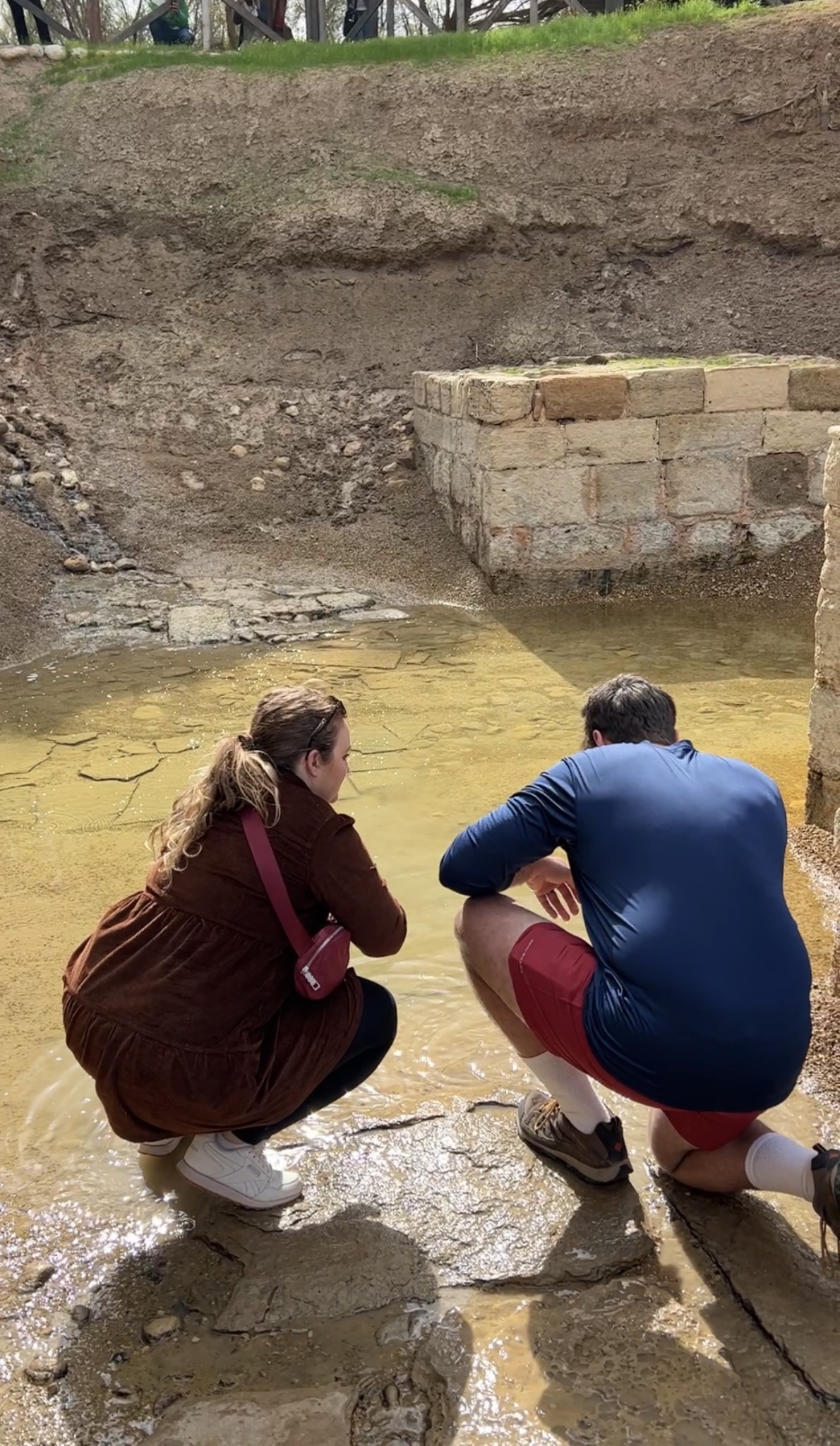
At the Jordan river you can see the border of Israel and you feel a certain kind of significance standing here. I also recommend stepping inside the Greek Orthodox St John the Baptist Church.
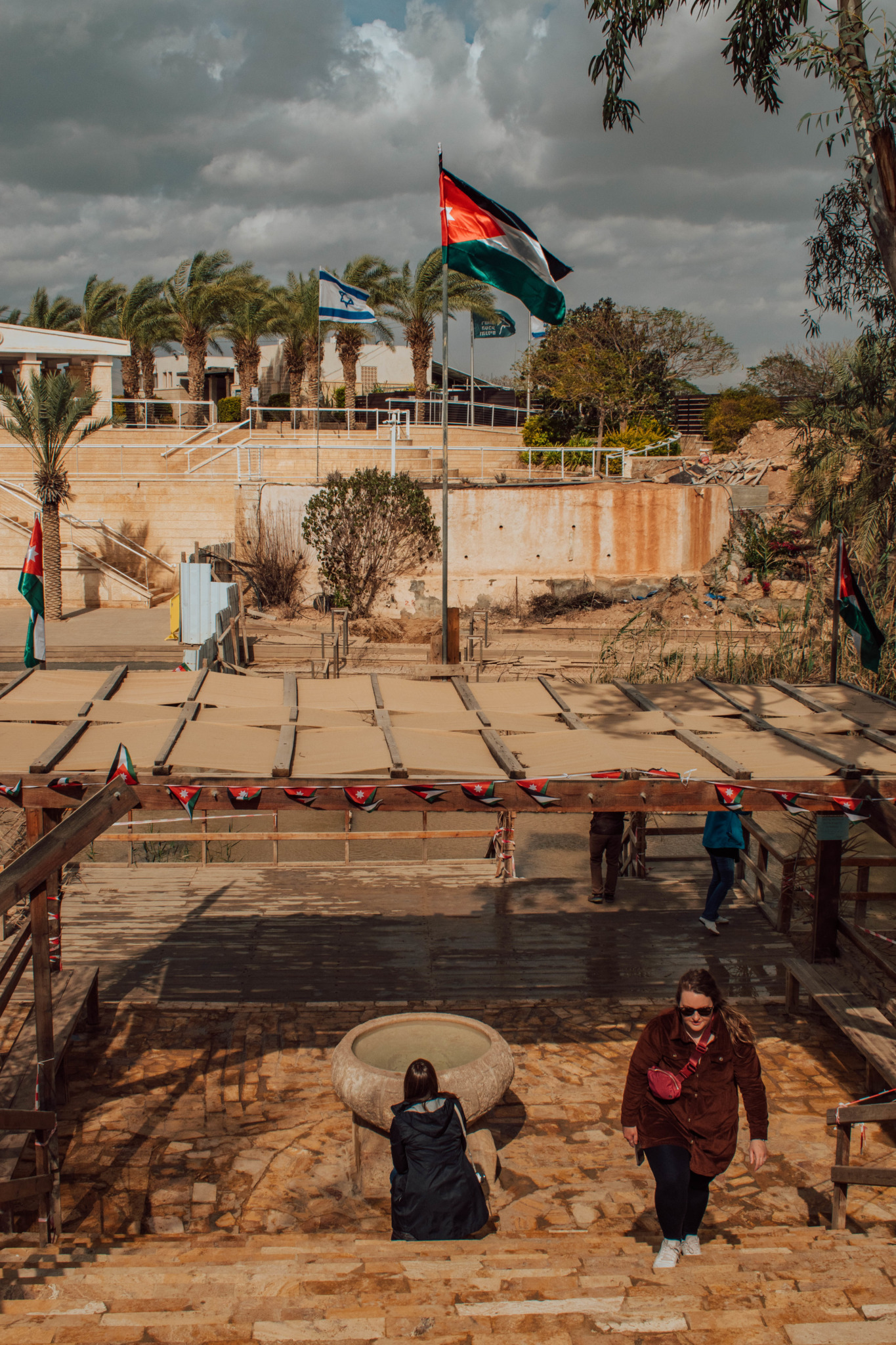

Next, we took a short drive to Madaba to see the world's oldest map of the Holy Land on the floor of St. George's Church. Known as the City of Mosaics the incredibly numerous mosaics lay untouched for over 1,000 years until they were uncovered when a new building project was started.
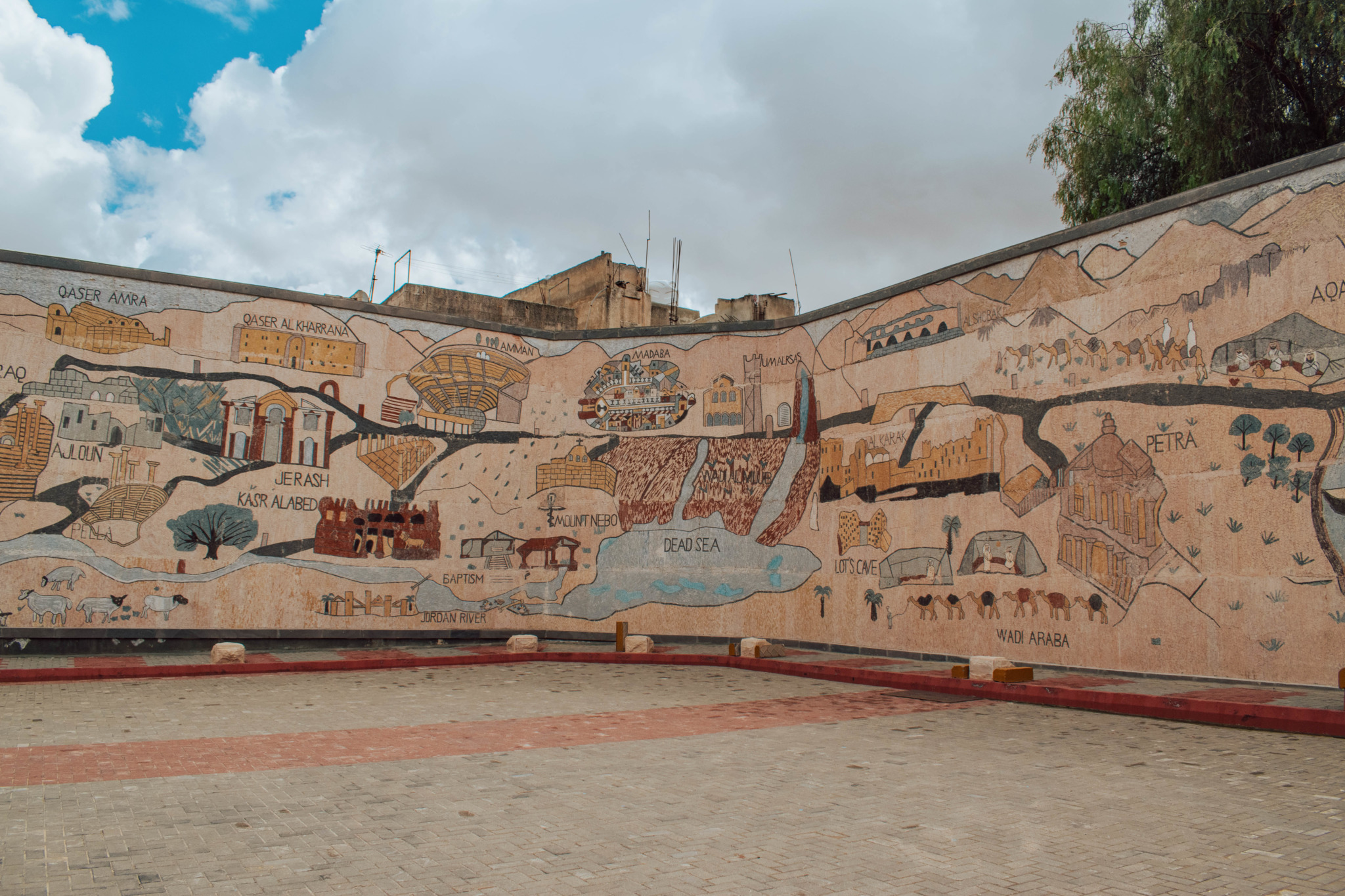
The Madaba Archaeological Park and Museum contains the ruins of several Byzantine churches, as well as the stunning Madaba Mosaic Map and the Hippolytus Hall, part of a 6th century mansion.
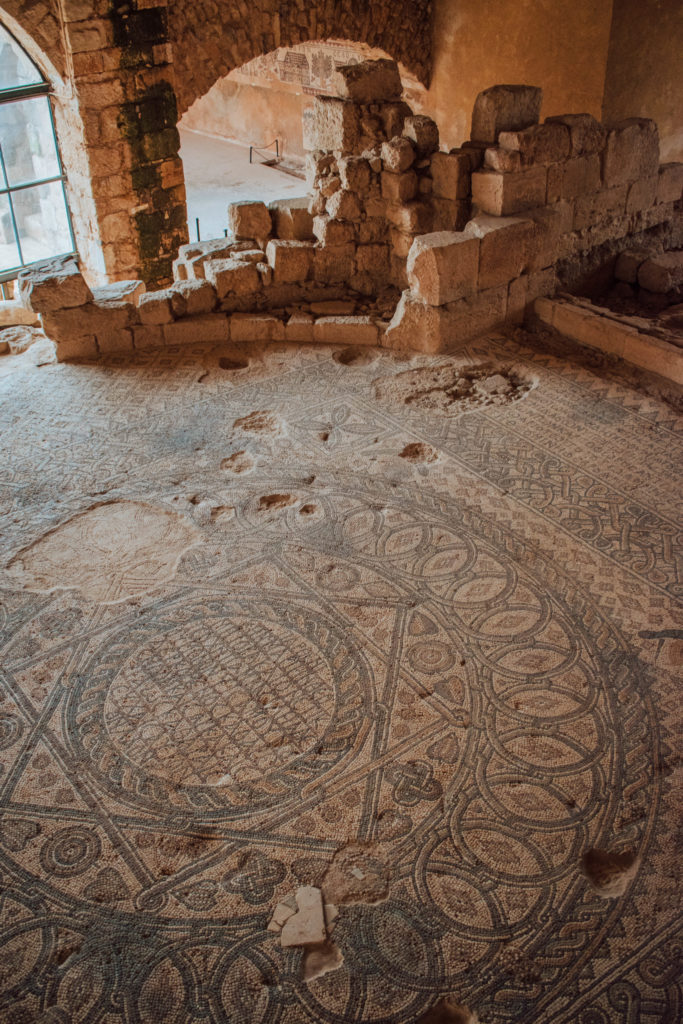
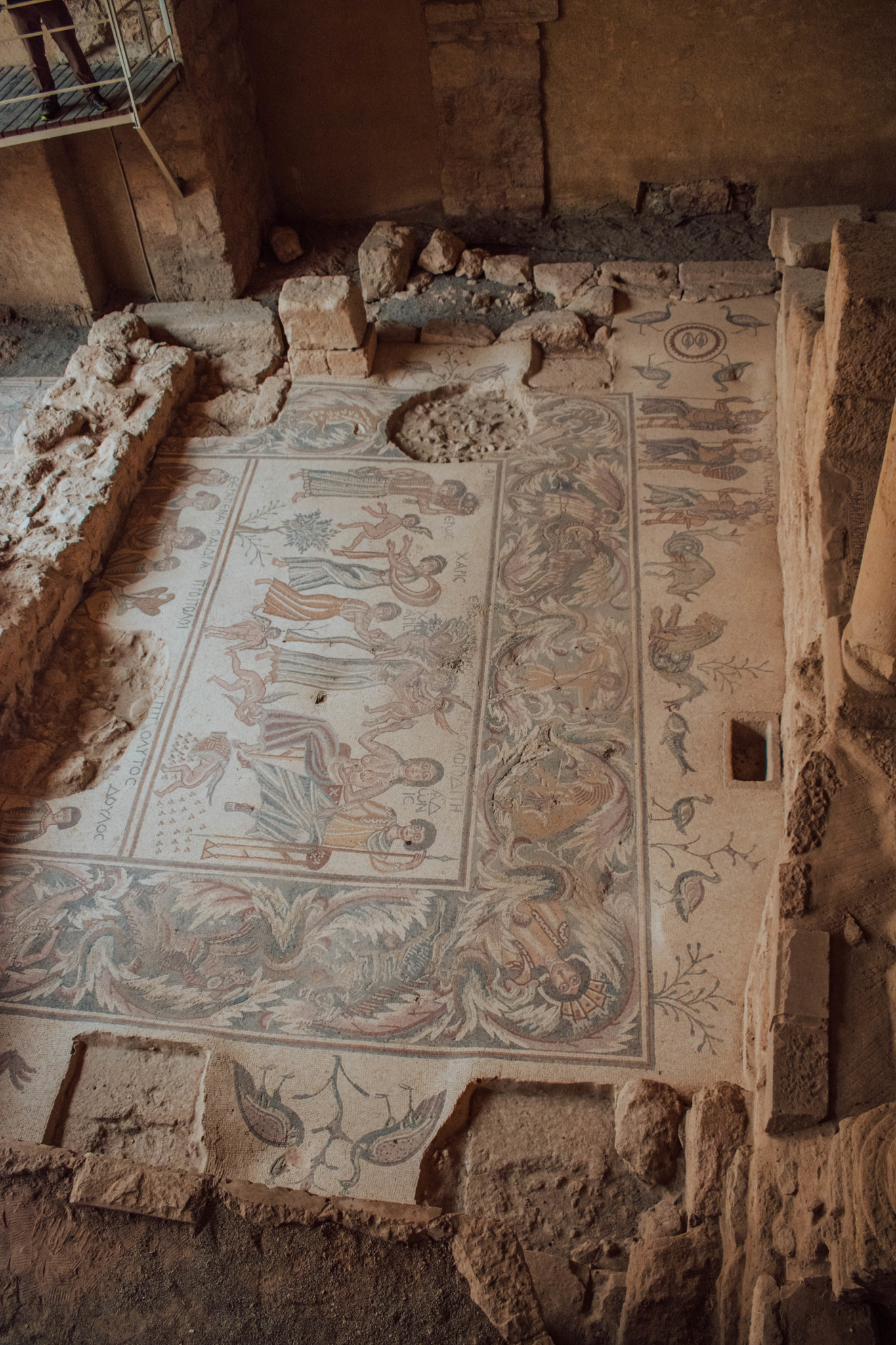
From here, we went to St. George's Church to see the mosaic map of Jerusalem of the floor in the church. The Mosaic Map was created in the 6th Century to help pilgrims get around the Holy Land. The Holy Land's sites are shown throughout Jordan, Israel, the Palestinian Territories, and Egypt's Sinai in detail. This helps prove the location of Jesus' baptism.
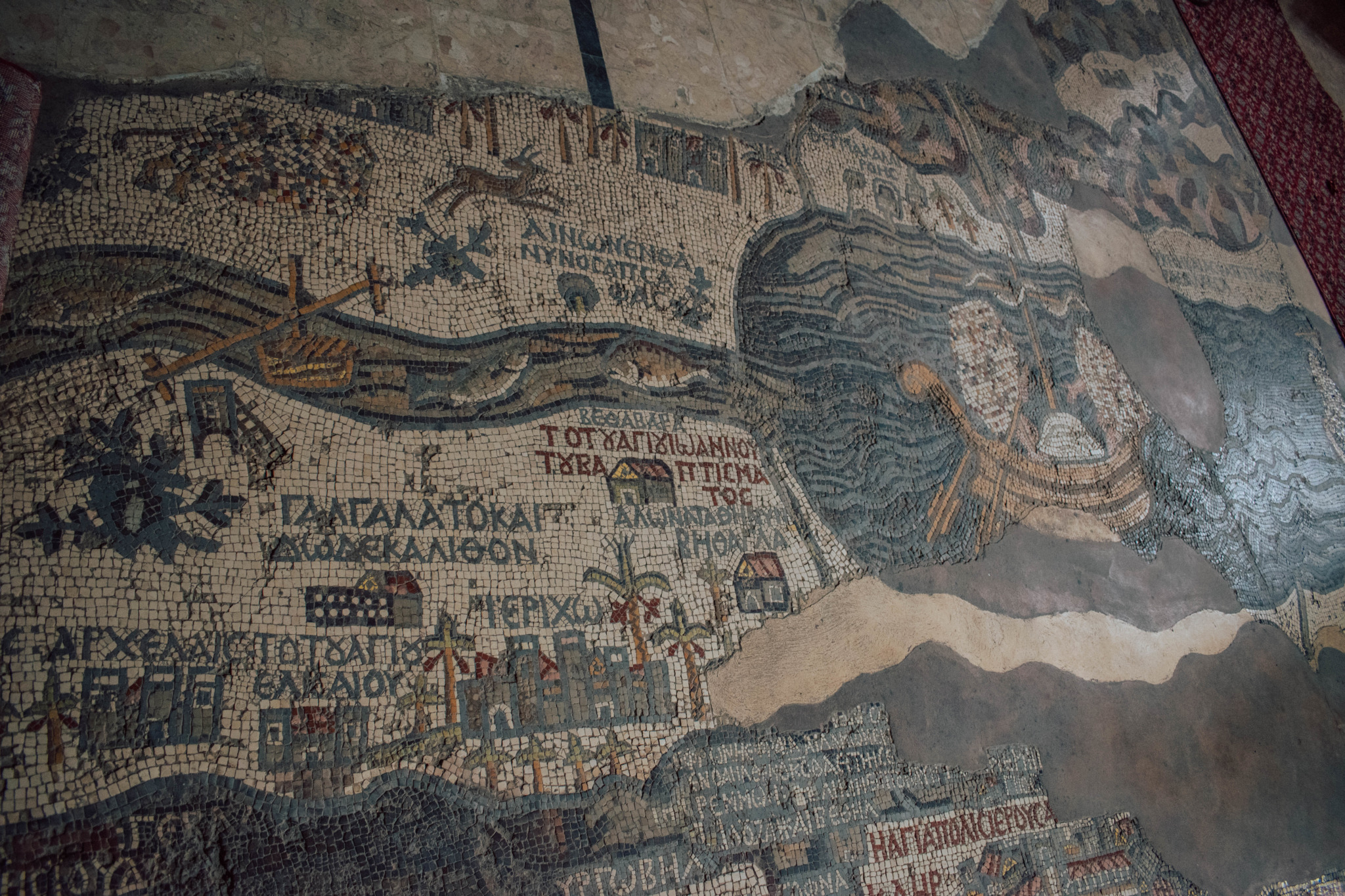
From the mosaics in Madaba, we made our way to Mount Nebo. This is where Moses surveyed the Promised Land of Canaan. God prohibited him from proceeding any farther, and he died before leading his people into it, according to the scroll. It is claimed that Moses was buried in this area, but no one knows exactly where it is.

After a long day of touring, we headed back for our last night at the Dead Sea and one more sunset.
Day 7 – Dead Sea & Amman
Globus arranges your easy transport back from the Dead Sea to Amman. It's about an hour's drive.
Our flight was early and Globus arranged to have a boxed breakfast ready to go. We had plenty of time to get to the airport and head home after a fabulous trip. You can check all the Globus Escape tours right here.
If you have more time…
Of course there's more to see in Jordan. If you have time, you can extend your time in the desert at Wadi Rum or take more time in Petra. Also Aquada is a place to see the Red Sea and, if you're up for it, go diving.
This was a whirlwind tour of some of Jordan's most incredible sites. I hope this travel guide helps you plan your one week itinerary (or more!) for Jordan! I highly recommend making your trip easy with Globus!


This post is in collaboration with Globus, but all opinions are my own.

